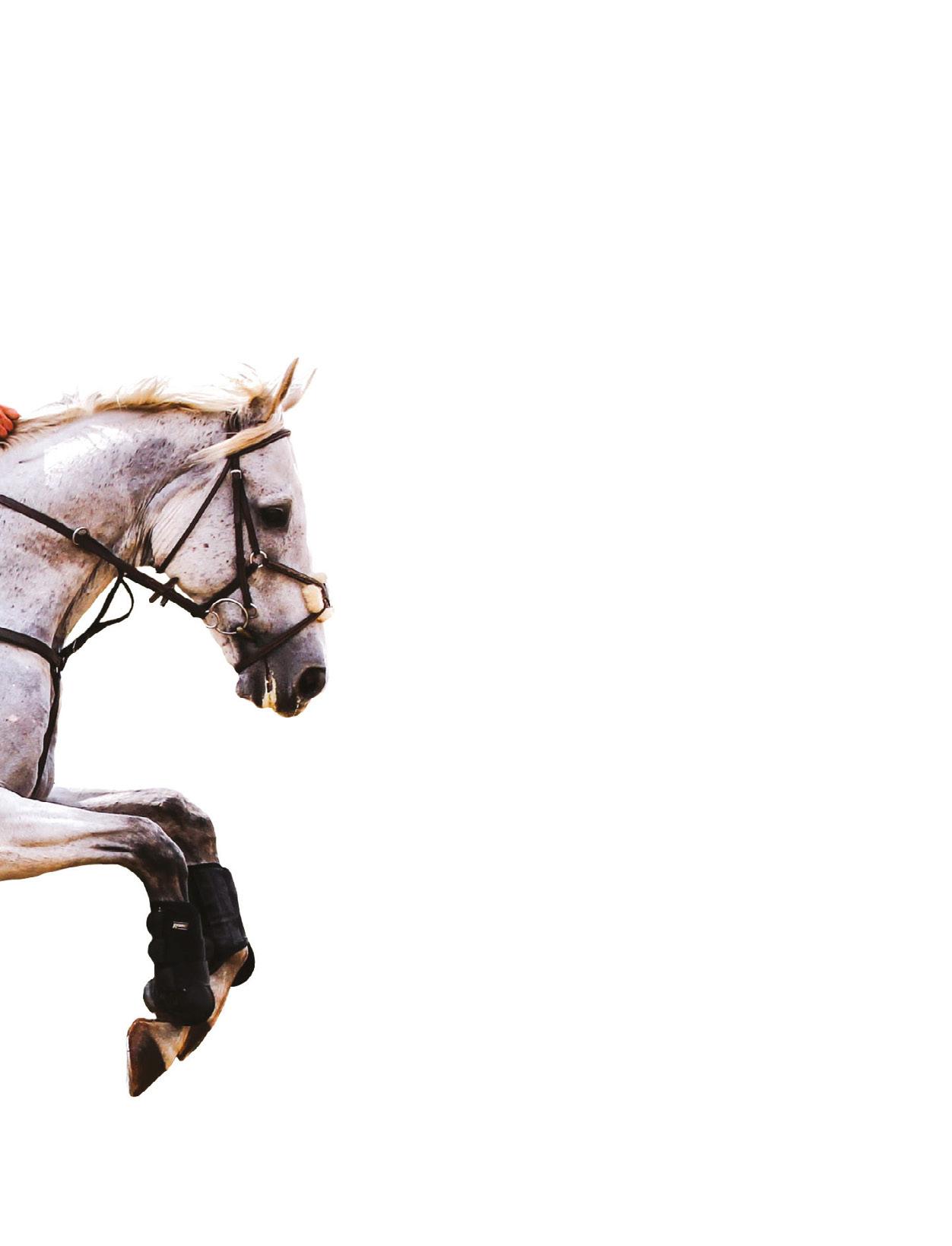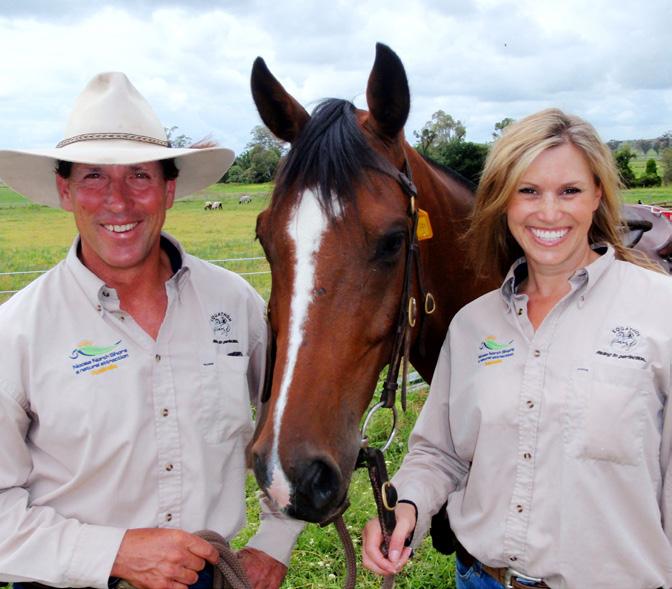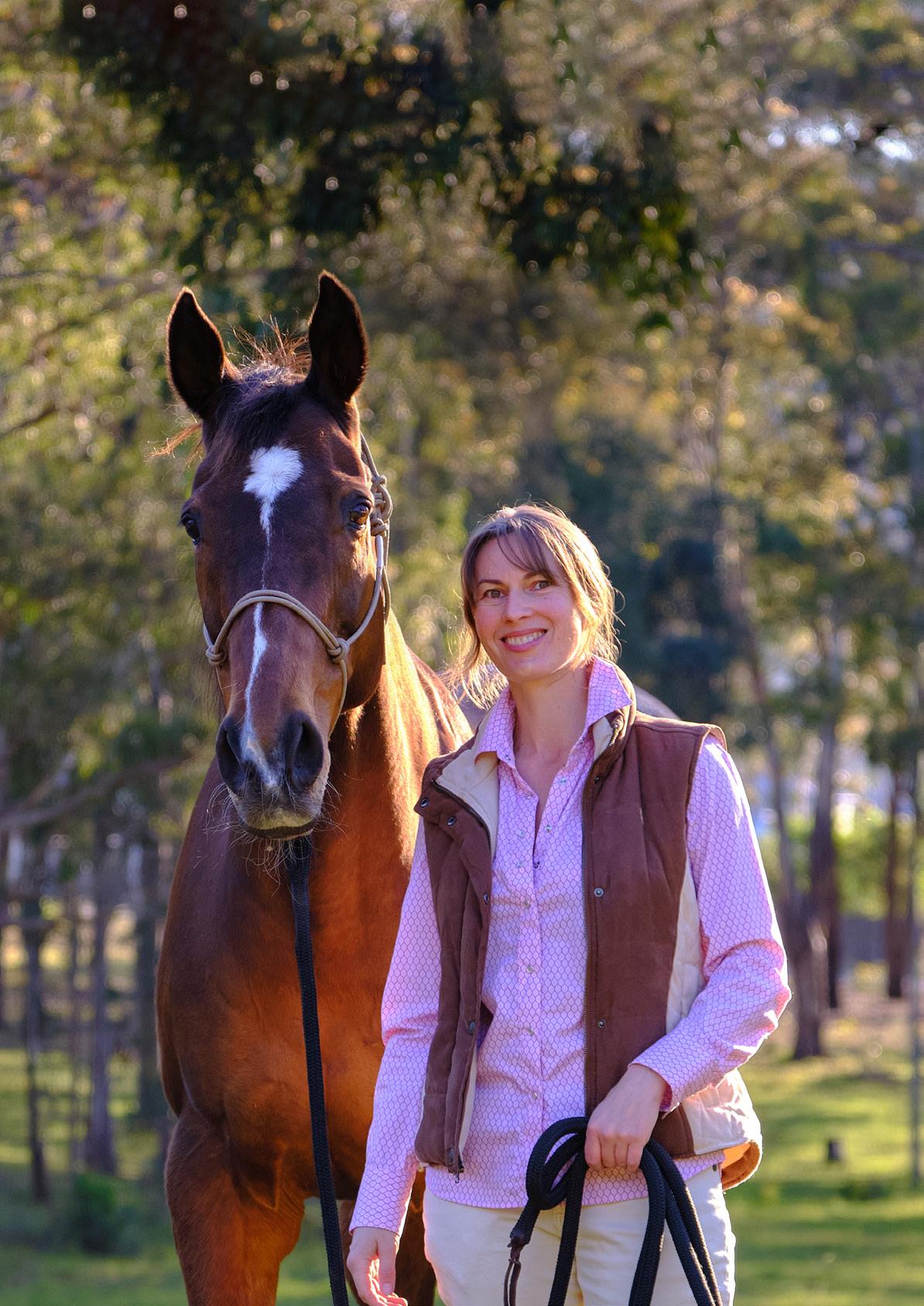
64 minute read
The Horse Listener
THE HORSE LISTENER
Big magic – the rebirth of Phoenix
Advertisement
CANDIDA BAKER talks to Jo Stacey about her extraordinary journey with her rescue horse Phoenix, and how ‘listening’ was part of their mutual healing.
Meant to be: Jo and rescue horse Phoenix (Image by Chris F. Porter).

Princess. Painter Jo Stacey is riding her rescue horse, Phoenix, along the beach at Port Stephens near Newcastle. “I was riding her bare-back,” Jo tells me, “and we were in such unity that day that I opened her up and let her gallop. I'd noticed four 4WDs and three dirt bikes up ahead, and when they saw us, it seemed they suddenly decided to have a bit of ‘fun’. They’d formed a wall in front of us - we were only a few hundred metres away from them and they were heading towards us at full speed.” The men had spread out, leaving no room for a galloping horse and rider to fit between them. “I knew stopping wasn’t an option. Horses are claustrophobic and it could have been dangerous,” says Jo. “As I had that thought, I felt her pace falter, and saw that she was looking back and up at me for leadership! So I did the only thing I truly know how to do, I ‘tapped in’ until I could see each individual.” Jo ‘spoke’ to Phoenix through her spirit. “I told her who the leader was, released the halter rope, and silently said ‘take him head on’. Phoenix adjusted her course slightly so she was facing him, and went flat out. Her speed was incredible - her normal gallop is easily over 40km/h - but this was something else,” Jo recalls. “In a matter of seconds they peeled off – almost colliding with
Savouring the gift of movement (Image by Cody
It’s like a scene from Xena, Warrior
Peachman).
each other to make way for this war horse! The moment we passed she slowed to a normal gallop, her ears went forward, and there was nothing within us but pure serenity.”
It seems when it comes to magic there are three kinds of people: the nonbelievers; the believers who are not sure how it works but know it’s out there; and those who are so finely attuned to it, that when it presents itself they jump in, boots and all. Such a story is Jo and Phoenix’s.
Jo was born in New Zealand, to a shearer father and a roustabout mother. “We moved around a lot,” she tells me, “I went to 15 different schools. My parents did a variety of seasonal work and shepherding. One of the places they managed was a 20,000 acre property owned by a Maori trust. I’d spend 12 hours or more on horseback, sometimes in the sleet and snow.” It was wild but Jo loved it.
Equine Facility Construction & Maintenance




WE TAKE THE GUESSWORK OUT OF ARENA LIGHTING
STABLE LIGHTING
Did you know that not all lights are the same. By choosing specific lighting for your horse stables you can improve your horses welfare whilst they are stabled. Our Light Bars directly replace fluorescent tube lighting and require no maintenance (No globes or starters to replace). They are impact and water resistant so good to use in the wash bay as well.
DoWell Equine “Take the Guess work out of arena lighting” by taking on board your requirements and creating a lighting plan that will provide you with the light you expect to receive before the lights are even installed. A customised lighting plan will enable us to reduce shadows and prove the Lux Levels and uniformity of the light. Our LED lights are the latest technology, and require little to no maintenance. We mean it’s likely that you will never need to touch these lights once they have
been installed!!!!



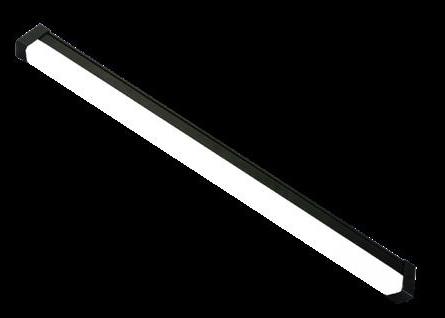
Jo’s love work includes paintings for the Brumby cause (Photograph reference by and courtesy of Michelle Brown).
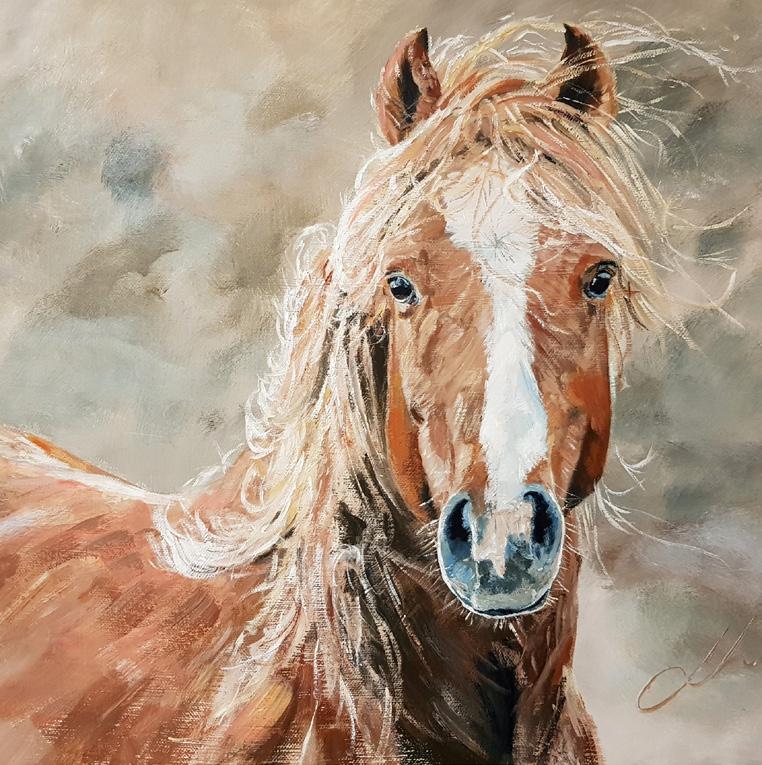
Sydney, Australia. “It was a complete culture shock,” she says. The sudden changes, serious unresolved earlier trauma, and unhealthy relationships caused Jo’s first nervous breakdown at age 18. Ten years later after her second breakdown, she decided to sell up and get out of Sydney, and almost immediately, her life turned around.
“I found the perfect cottage in the Hunter Valley at Millfield,” she says. “I bought it, started painting, and later finished my psychotherapy qualification, as well as working as a railway Traffic Officer. I was also helping with animal husbandry at the local Hare Krishna farm, and they asked me if I could find a horse for them.”
Jo wasn’t quite sure where to start looking, but magic was about to happen. “I was on a break at work on the railway in Clyde,” she says, “and a voice came through the air and said to me: ‘That man over there knows where your horse is.’”
Some might have hesitated, but Jo, used to these kinds of occurrences, went over to him, introduced herself and told him she was looking for a horse. After
pausing thoughtfully, he told her one was waiting for her at the Rutherford RSPCA.
Jo made an appointment and went to see the horse. “I walked into her paddock, and her head was hanging on the ground,” she says. “I stood about 20 metres away and waited, and suddenly her head shot up and she looked me straight in the eyes – the connection was so intense. She knew me and I knew her.”
The vet explained that her injury – severe pedal osteitis – made her unrideable. But Jo had a knowing that he was wrong. “Then he told me she had cancer that they hadn’t been able to cure, but I said that was fine, I would look after her,” she says.
Four days later Jo bought Phoenix from the RSPCA for $500, but not for the Hare Krishnas' farm!
Despite Jo’s faith and optimism, Phoenix could hardly walk, and thanks to abuse she was scared and violent, although not towards Jo, who went on a steep learning curve to care for her. “I learned about laminitis, hooves, horse feed and how to be a barefoot farrier, and I healed her feet as best I could,” she says. “When we started riding, she spent a lot of time rearing. I never got the feeling she actually wanted me off her back, so I would just sit it out, until gradually she did it only out of excitement.”
Jo delved into Phoenix’s past and found that after her racing career she’d become a brood mare, but unable to produce a healthy foal, she was moved on. “We don’t know where she ended up but she was finally surrendered to the RSPCA emaciated,” she says.
Once Phoenix could walk, Jo decided they would get fit together. “We’d sprint up hills,” she says. “I’d do it first and then it was her turn, and she started to put weight and muscle on. She’s 22 now and still has abs, with no sign of the cancer.”
When they started their beach work, the RSPCA came out to watch because they simply didn’t believe the photos Jo had sent them. “I discovered her pedal bone had been completely snapped,” she says. “What we’ve achieved through faith and love is remarkable and she is both grateful and giving. A few years ago we went up a hill to watch the sunrise for her birthday. I
packed breakfast and included all her favourite things. She was so moved by the experience that she walked away, picked a mouthful of grass, and put it in my lap as a thank you.”
A favourite memory is of the day Phoenix discovered she could run again. “I’d gone out to the Hare Krishna farm to spend the day with Phoenix,” she says, “and when I arrived a guy who worked there came running up to me, terrified by what Phoenix was doing. And there was Phoenix between two trees as if she was in the barriers at a race, suddenly exploding out from the trees and galloping to the other end of the paddock.”
As Jo sat and watched, Phoenix did it over and over again, obviously relishing the sheer joy of movement. “That was about four years ago, and that was the day she got her feet back,” she says.
But if Jo gave Phoenix the present of rebirth, the gift has been returned in numerous ways, one being Jo’s commitment to painting. “I wanted to honour her,” she says, “so I picked up my paintbrush and started to paint. Over time my portfolio built to the point where I could also do ‘love’ work. Everything I do, every brush stroke, I do for her.”
As Jo and Phoenix developed their relationship, Jo wanted to use her psychotherapy skills to help people heal from trauma. As these journeys unfolded, she realised one day that she herself was healed. “All the horrors and betrayals as a child, and the adult misadventures that resulted - I’d just let it all go,” she says. “I choose life, love, genuine connection, and unity. And Phoenix? Well, we chose each other. I am her guardian and I will stand with her until the very end. It’s my greatest honour.”
Recently, Jo found Phoenix a companion. She’d been searching for the ‘right’ one for some time - enter Molly, a retired Standardbred, who is now Phoenix’s constant companion, and is beginning her new life of love and magic with Jo and Phoenix.

You can find Jo, Phoenix, and Jo’s paintings on www.paintandpony.com
Candida Baker has a Facebook page, The Horse Listener and is President of the equine charity Equus Alliance.

TOP: Jo and Phoenix share an unbreakable bond (Image by Chris F. Porter). ABOVE: Phoenix in care with the RSPCA.

Winners of the 2017 Sydney Royal Hack Championship. Rebecca and Stage Presence with hack judge and international dressage rider Kristy Oatley (Image by Julie Wilson).
LIFE AFTER RACING
Staging a comeback
After a less than auspicious racing career, OTT Thoroughbred Stage Presence and Rebecca Farrow joined forces with spectacular results, writes JO MCKINNON.
Rebecca Farrow is one of the queens of the Australian show ring. From a very young age, the Victorian rider has dominated competitions not only in her home state but throughout Australia. And in recent years she has been next to unbeatable on her big, flashy Thoroughbred gelding Stage Presence.
Known as Percy around the stables, Stage Presence is aptly named given his markings and general ‘wow’ factor. Wherever he goes he turns heads and more often than not, judges at major shows all over the country are taken with his good looks and impressive movement.
Now a 12-year-old, he’s one of the most decorated show hacks currently in competition. “He’s been remarkable, he really has,” says Rebecca.
Since purchasing him from Courtney Smith as a novice level Royal Show hack five years ago, Rebecca has won almost everything there is to win with him. In 2017, the pair scooped both the Champion Hack and the Champion Lady Rider at the Sydney Royal Easter Show. Notably, it was the first time in 46 years that an owner/ rider combination had managed this truly amazing coup. To further sweeten 2017, they also took out the National Off the Track Championship.
The son of Testa Rossa, a multiple Group One winner and a prolific sire of winners, Stage Presence raced under the name Persistency. However, he was a rank failure on the track. He had only one start, which was at Scone in a maiden where he finished ninth of 14 runners. He was beaten by eight lengths and was retired not long afterwards.
But what he lacked on the race track

he has since more than made up for at the very top of the highly competitive show scene. “I first saw him at Sydney Royal when he won the novice large hack over 16.2hh,” says Rebecca, “and I thought he had a beautiful way of going. I then watched him in the best novice class and thought ‘I love that horse’. He was soft across the ground, had a lot of air under him and was really leggy. He was lean and green but had a nice way of travelling.”
Through a mishap with her own horse at the Sydney Royal that same year, Rebecca needed to borrow a horse for her rider class. The opportunity came up to ride Stage Presence and she jumped at it.
They clicked straight away and after riding him for just five minutes in the marshalling yard, the pair strode into the main arena and went on to win the class. Rebecca offered to buy him soon after but it took Courtney two months to finally make the decision to sell.
But just six months after Rebecca took ownership of Percy, tragedy came
An impressive pair: Rebecca and Stage Presence at the 2019 Sydney Royal (Image by Julie Wilson).
Joddy socks to brighten up your day $19.95 or $15 for Gold and Platinum members https://membership.equestrianhub.com.au Equestrian Hub Membership perks



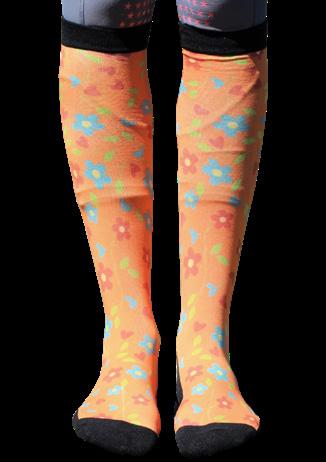
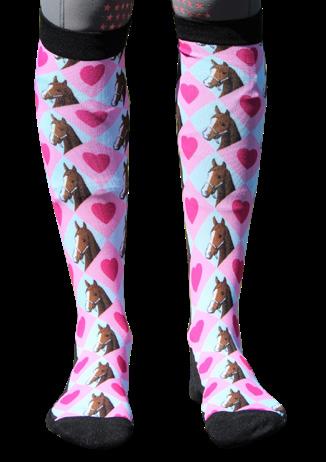
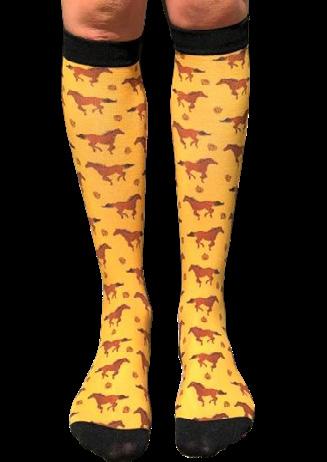
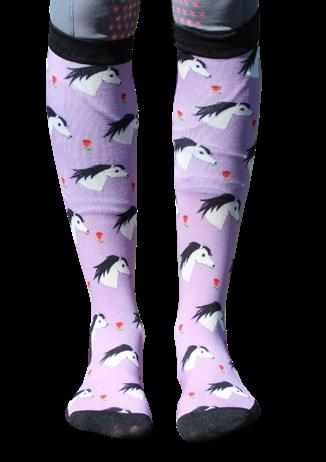
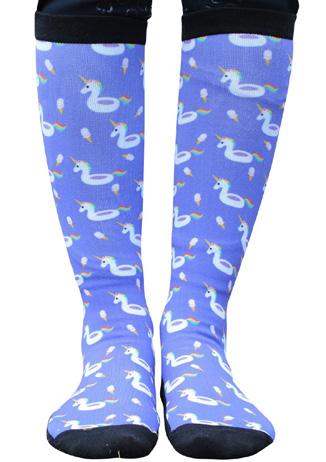

perilously close when he developed a bad bout of colic. After costly lifesaving surgery and a year off he pulled through, much to Rebecca’s relief. “It was a long recovery. He lost 100kg in five days, but he had an 80 per cent chance of making a full recovery, so it was money well spent. I would not otherwise have the great horse I have now,” she says.
Rebecca loves working with Thoroughbreds. Over the course of her career in the saddle, she’s had at least a dozen retired racehorses but says Percy epitomises the many great attributes of the breed. “I think when you stand him up and look at him, you realise that it’s very rare to find a 17hh horse so well put together. He has a great length of rein, long legs and is a very sound horse. He’s never had a day’s lameness in his life.”
According to Rebecca, even as a youngster Percy showed great promise: “I’ve seen a picture of him as a yearling and he was a cracker. Bio-mechanically he is so good. He has that rare quality in a Thoroughbred in that he’s a great mover but not all up in front. He moves more like a Warmblood. He’s got a great swing and softness in his back.”
She says his temperament is second to none and describes him as an absolute pleasure to ride. “He’s really

beautiful to ride and he’s a very rhythmic horse to watch. He’s now quite an uncomplicated character. He’s very well educated, he loves his work, and he doesn’t get frazzled when you put pressure on him to learn new things. He’s a horse you want to ride all day.”

Together they make a stunning combination and in 2018 their crowning achievement was winning the prestigious Garryowen Perpetual Trophy.
Due to the COVID-19 related
Stage Presence, the 2017 Racing Victoria Off The Track Ridden Thoroughbred Champion (Image by Julie Wilson). BELOW: There’s no place like home (Image courtesy Rebecca Farrow).
cancellation of horse events all over Australia, 2020 has been devoid of any success. They have not competed at a major event since the nationals last December.
“It’s pretty frustrating,” Rebecca says. “Initially, I used the time off to train, work around the property, redo my tack room and stay focussed. I’m now using the downtime to rehabilitate from an injury. I’ve kept Percy in light work, just at a maintenance level really.”
Rebecca was recently nominated for the Equestrian Victoria Rider of the Year award. The recipient of this accolade will be decided by a panel of judges in the coming weeks.
In the meantime, her main aim after returning to competition is to try and fulfil a lifelong ambition to win the Pope Cup at one of the Royal shows. “My dream is to win a Pope Cup with Percy. He’s such a big, scopey, Pope Cup type. That’s one I would like to tick off the list,” she says.
We wish Rebecca and Stage Presence the very best of luck with their dreams and a speedy return to the show ring when competitions are finally back in swing.
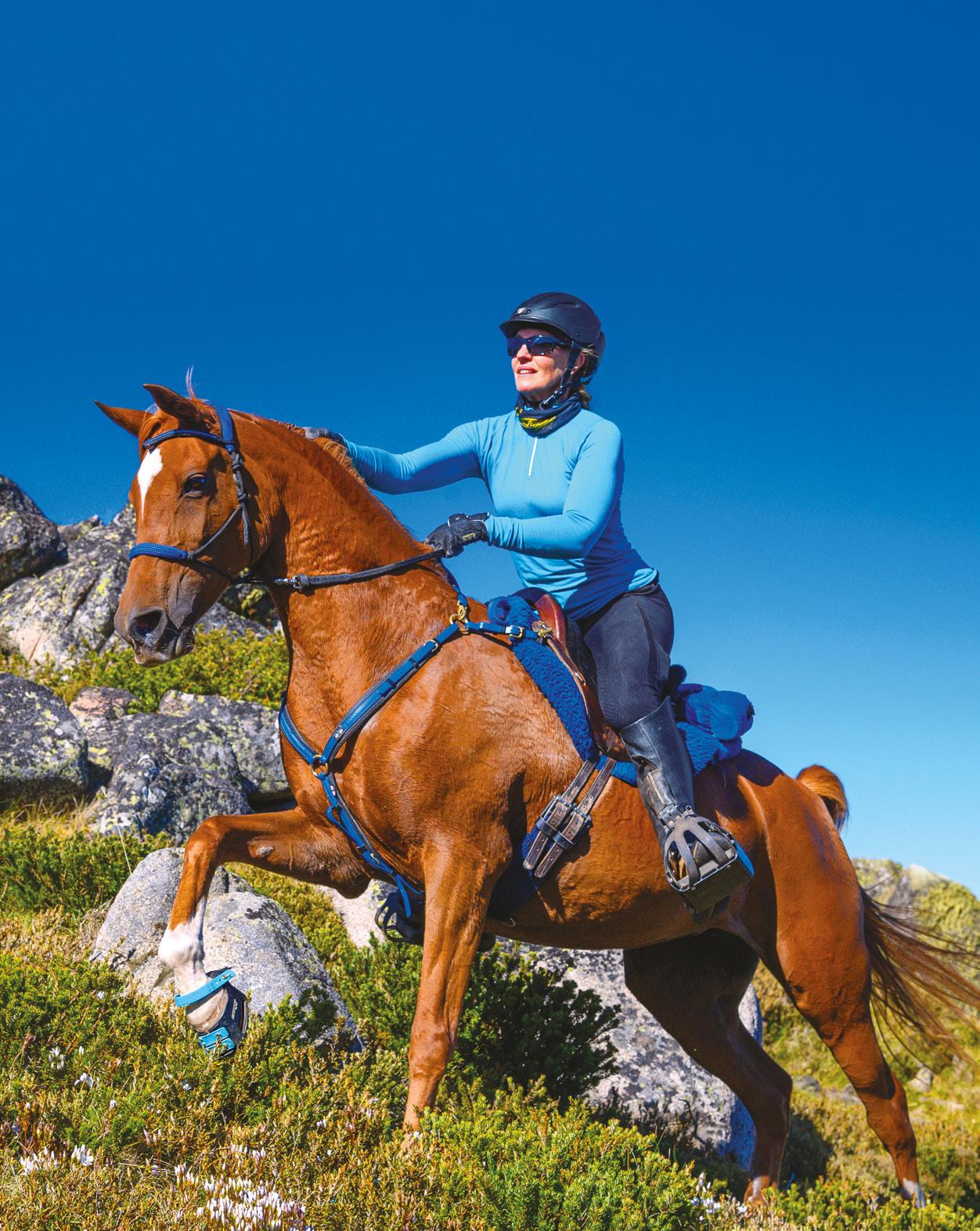
HORSE BREED
The elegant Thoroughbred
19th Century English novelist and playwright John Galsworthy once said “... there is nothing alive quite so beautiful as a Thoroughbred horse”. Was he right? FRANCINE PULLMAN takes a closer look.
With names like Phar Lap, Winx and Black Caviar so familiar to us all, it’s no surprise that the Thoroughbred is one of the best-known horse breeds in Australia. Admired for their athleticism and high spirits, they’re certainly a delight to behold.
Whether off the track or never raced, they can make the perfect equine partner in a number of disciplines, but their excitability does mean that they’re not the ideal horse for every rider. The facts of the matter The Thoroughbred is perhaps best known for its role in the horse racing industry. And let’s not forget that they’re also a royal favourite: Queen Elizabeth II has been breeding racehorses for many years, while Godolphin is the global Thoroughbred breeding operation and horseracing team founded by His Highness Sheikh Mohammed bin Rashid Al Maktoum.
Renowned for their speed, agility and lean good looks, Thoroughbreds are usually bold, intelligent and extremely athletic, making them an attractive option for many equestrians at all levels of competition. Olympic equestrian star Andrew Hoy is an enthusiastic exponent of their virtues and with good reason! Davey, an OTT Thoroughbred, carried him through two Olympic Games, two World Championships, and won Burghley. Meanwhile Olympic eventer Boyd Martin partnered with a 12-yearold OTT Thoroughbred for the 2016 Olympic Games in Rio de Janeiro.

With approximately 600 horse breeds globally, the Thoroughbred is one of the most popular. Around 100,000 Thoroughbred foals are born worldwide each year, with Australia producing some 15,000. Breed history The story of the modern Thoroughbred can be traced back to 17th and 18th Century England, and the arrival of three foundation stallions from the Middle East: the Byerley Turk, the Darley Arabian and the Godolphin Arabian. Even though the stallions were never raced, they became the founding fathers of today’s Thoroughbred racehorse.
The Thoroughbred foundation mares were mostly smaller native breeds, both local and imported. Interestingly, most of today’s Thoroughbreds can be traced genetically to just 30 animals from the 18th and 19th centuries (three mares and 27 stallions), initially raising some concerns regarding a limited genetic pool.
Selective breeding over 300 years has resulted in the Thoroughbred we know today, typically a horse with fine build, lean body type, great strength, speed, and stamina.
Horses arriving in Australia with the First Fleet in 1788 were most likely Thoroughbred crosses. The first pure Thoroughbred to be imported is thought to have been Northumberland, a stallion who arrived from England in 1802 for the purpose of siring coach horses. By 1810, Sydney had held its first formal race meet, and in 1825 the first mare of proven English Thoroughbred bloodlines arrived, followed throughout the 1830s by more Thoroughbreds imported for the purpose of improving local stock and for racing. Hey good looking Thoroughbreds have a fine build with a long, elegant neck, a chiselled head and a straight profile (the dished face of their Arabian ancestors is now rarely in evidence). With their deep chest, high withers, short back, strong hindquarters, lean body and long clean legs, the overall look is athletic, powerful and elegant.
Standing anywhere from 15 to 17hh, they are mostly bay, black, chestnut, or grey. Their coat is fine and glossy with minimal leg feathering, and white markings on
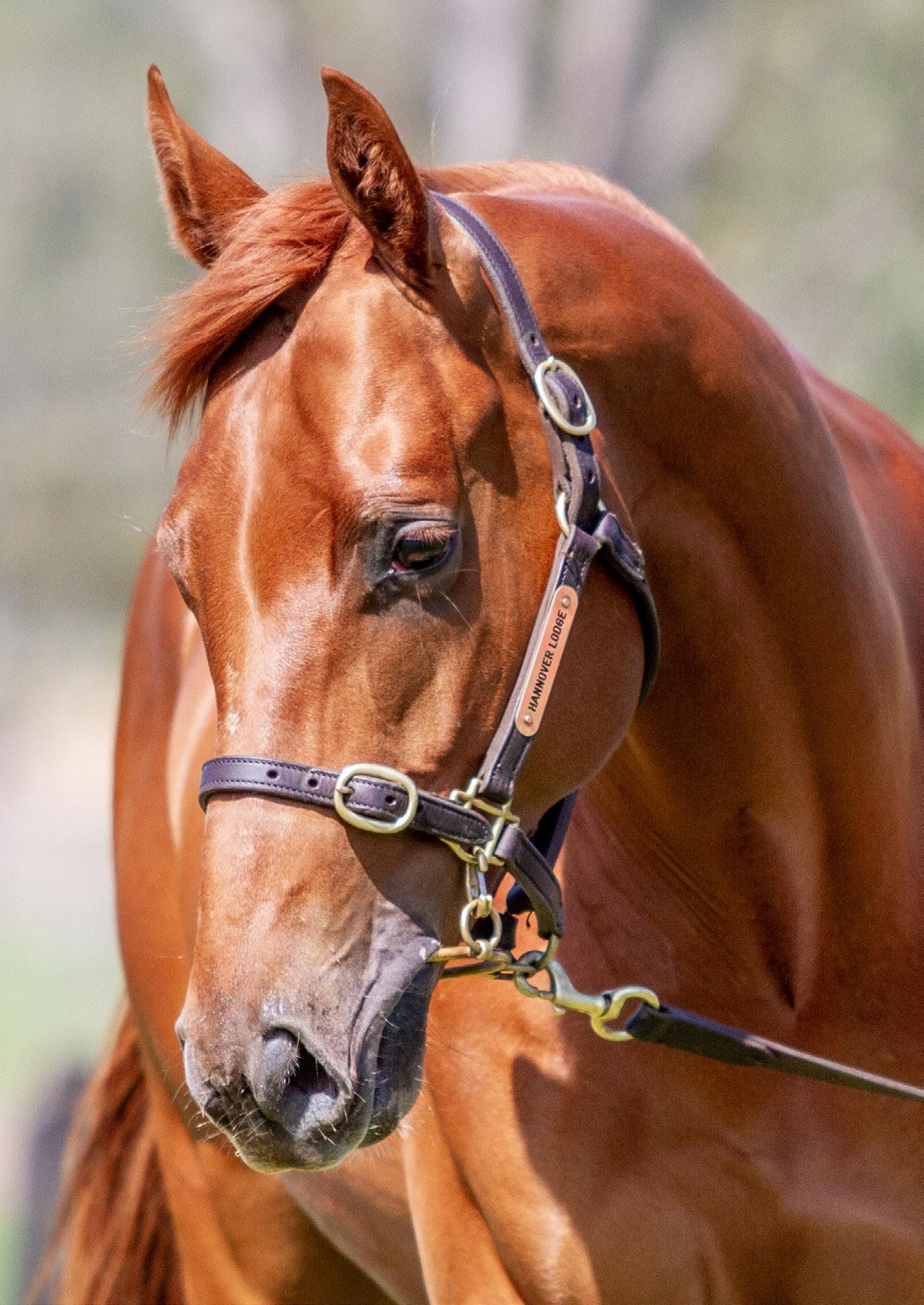
MAIN: A stunning twoyear-old Hannover Lodge Thoroughbred colt by Starcraft out of Wangalla (Image by Melissa Goodson). INSET: Bold and curious, this youngster shows promise.

Purchasing a Thoroughbred may be more affordable than you think.
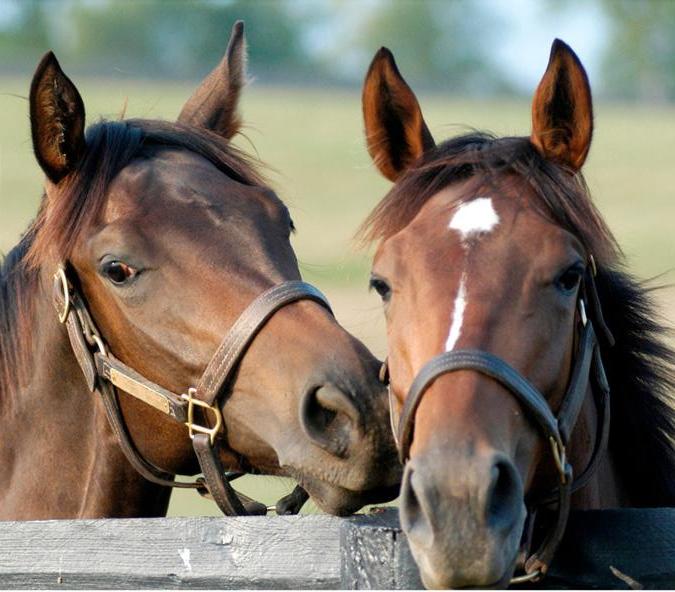
the face and lower legs are acceptable. State of mind Generally considered to be a hot blooded breed, the Thoroughbred is spirited, bold and fast. However this helps to give them the presence often sought by more competitive riders. They are intelligent horses and thus trainable, but they can be quite reactive, which riders may experience as a tendency to shy at their own shadow, or fire up on a windy day.
They are an energetic and forward moving ride, potentially making them a challenge for beginners or nervous riders. However, in many cases, these characteristics can and do mellow with age, making an older more experienced Thoroughbred a good schoolmaster for the less experienced equestrian. Health check If you are considering a Thoroughbred who has raced or been trained for racing, you should be alert to past injuries. Under heavy work they can be prone to bleeding from the lungs and some develop laryngeal paralysis
leading to a condition known as roaring.
A small hoof to body weight ratio can cause ongoing footsoreness and lameness, plus they often have thin soles and usually require shoeing. Orthopaedic problems including fractures can be common if the horse has been subject to high stress activities, such as racing and jumping, particularly on dry, hard ground.
As many as five per cent of Thoroughbreds specifically bred for racing suffer performance issues caused by too small a heart. Persistent behavioural issues caused by long periods of boredom in the training stable are common and include weaving and wind sucking.
If you’re contemplating buying a Thoroughbred, a vet check is always a good idea whether the horse has been raced or not. Feeding Thoroughbreds have a fast metabolism so generally require pasture and supplemental feeding to maintain a good body weight. However, the advice of an equine nutritionist is always advisable to ensure that you get the balance right. Too much concentrated feed or rich spring grass can add a little too much spirit to that feisty temperament!
Colic and stomach ulcers are more common than with many other breeds, another reason why extra care should be taken to provide a correctly balanced diet. So you want a Thoroughbred While taking on a Thoroughbred who’s being retired from the track can seem like the right thing to do, there are a number of factors that should be considered. Due to this breed’s hot temperament and particular needs, your new horse could cost you much more than the purchase price in vet bills, feeding, training, and even lost confidence if things go wrong.
Some states have an Off the Track program designed to help retired racehorses find another role in life. Racing Victoria, for example, has established a network of experienced retrainers who help smooth the transition by working with each horse to assess which new career might best suit them.
So, if your heart is set on a Thoroughbred, and you love the idea of giving an OTT horse a home, investigate the re-training programs and see what they have on offer. How big is your budget? Ironically, while many Thoroughbreds in the racing industry are sold for
ABOVE: Spirited, bold and fast, Thoroughbreds are perhaps best known for their racetrack prowess.

breathtaking amounts well into the millions, the Thoroughbred is still considered to be one of the cheapest breeds to buy, simply because there are so many of them.
And so if you are considering purchasing a Thoroughbred either straight off the track, or re-trained, or from a breeder, you may not need to part with as much money as you might have thought.
While Thoroughbred yearlings regularly sell for many thousands of dollars to investors hoping to find the next Black Caviar, within a few short years many of these horses are rejected by the racing industry and sold off for significantly fewer dollars, or even given away.
So price isn’t necessarily a barrier, nor is it a good indicator of breeding, trainability or athletic potential when buying a Thoroughbred for purposes other than racing.
As an aside, one of the most expensive Thoroughbreds ever sold was American bred Fusaichi Pegasus. As a threeyear-old colt he was sold for more than US$60 million after amassing $2 million in winnings. He retired to stud but was considered a disappointing sire and died fairly young. Find (sire Gonski, grandsire US Danehill) was sold for $32,000 at the 2010 Magic Millions Yearling Sale. After collecting just $26,000 in race winnings from 35 starts, he was retired in 2013 as a failure and sold for $500 to a Pony Club rider. He went on to enjoy a new lease of life as a much loved and useful all-rounder. An OTT story with a very happy ending! Want to know more? If you’re on the hunt for a Thoroughbred here are some links to follow up:
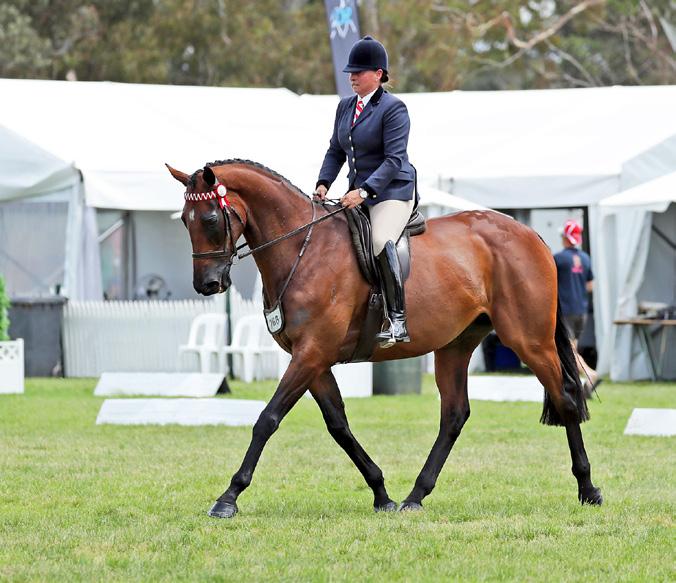
Fiona McIntyre and OTT Thoroughbred Precedence excel in the show ring (Image by Angie Rickard Photography).
Thoroughbred Breeders Australia www.tbaus.com; registered charity Recycled Racehorses recycledracehorses.com.au/; the Aquis Farm retirement program aquisfarm.com/racehorse-retirementprogram/; horserescueaustralia.org.au; the Transitioning Thoroughbreds Foundation www.transitioningthoroughbreds.org; and International Thoroughbred Retirement internationalthoroughbredretirement.com/.
SNAPSHOTAUSTRALIA “You make the moment, we capture the memory”

@johnsoneventing

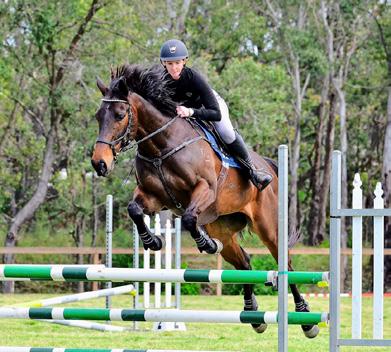
@eventing_courtney

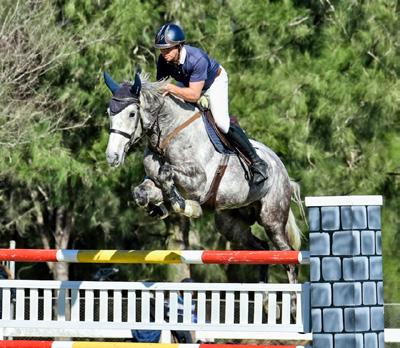
The inaugural 2013 Remi Scholarship recipient Isabella WilkinsonMcIntyre and Remi Livingstone S were awarded EQ Runner Up Newcomer HOY 2019, and have been selected on the Talent Recognition Squad for 2020 (Images courtesy of Geoff McLean, Gone Riding Media).
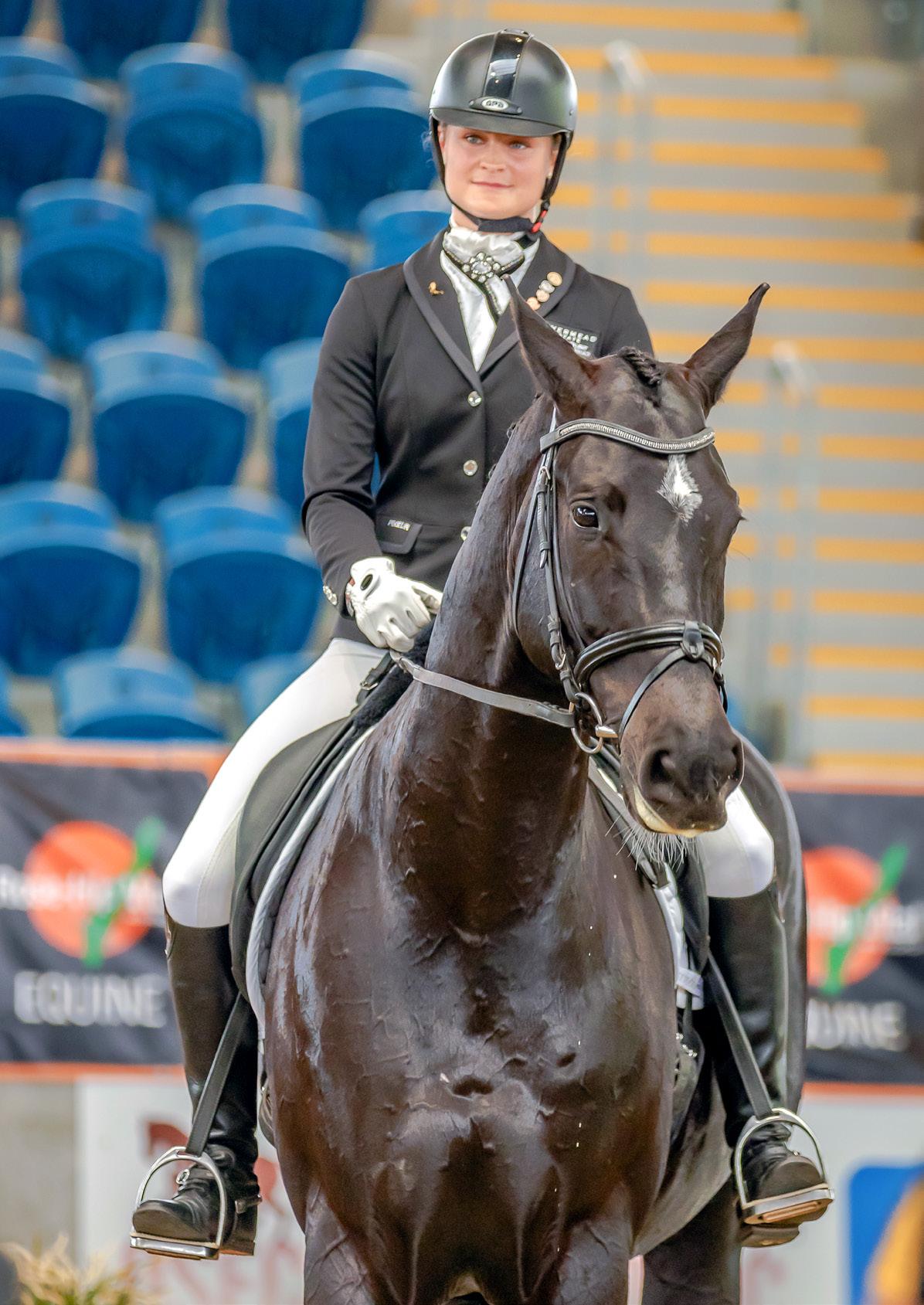
Accullenitis vellant labo. Officias sustinc ipient facimpe vererro quibusae. Ficimol orporrum lamus dolendi aboris earum sitatquis ut laut velecta turione ctiusam, tore conet iligent que sunt dolupta tecupta vernatus ea core volorit alitata quidebit qui
FEATURE
Remi Stud Young Rider 2020
Remi Stud is Australia’s home of internationally bred Hanoverians. Each year, the stud presents an up-and-coming young rider with a substantial scholarship, writes GEOFF McLEAN.
First offered in 2013, the Remi Stud Young Rider Scholarship is an annual award gifted to a deserving young rider who has the talent and dedication to succeed either in dressage, showing, or eventing, but who needs assistance in order to achieve their dreams.
The scholarship, prepared by Cheryl O’Brien from Remi Stud, includes ownership of a purpose bred Hanoverian weanling by Lauries As (imp), one of Australia’s best performing Hanoverian stallions.
The young horse awarded as part of this year’s scholarship was a nine-month-old weanling filly Remi Laurentia S (aka Tia) by Lauries As out of the mare Remi Veuve Clicquot. The filly was part of a scholarship package valued at over $30,000. The package was supported by an broad range of sponsors including Prydes Easifeed, Equestrian Queensland, Equestrian Australia, Brisbane CDI, HorseForce, Edwards Saddleworld, Lord Dressage (in conjunction with Team Van Den Berge), Dr Show, Belrock Equestrian, Westvets, the Hanoverian Horse Society of Australia, Meaker Farrier Services, Kelato Animal Health, and Manuel Equine Transport. McNichol (Victoria), who among many other roles has served as the Australian dressage team’s Chef d’Equipe; Ros Lipp (Queensland), an accomplished dressage rider and co-owner of Saddleworld Toowoomba; and Cheryl O’Brien (Queensland) owner of Remi Stud.
This year’s scholarship was presented to 17-year-old Elise Payne of Ourimbah
Mathew Lord and Remi Laurentia S.
NSW during a ceremony at the recent Saddlefitter Brisbane CDN. Elise, who is coached by Melanie Schmerglatt, has had a passion for horses since the age of four and is certainly a deserving winner.
The journey for Elise and her family has not been easy. Her parents, while not ‘horsey’, understand and encourage their daughter’s passion. Her father a Vietnam war veteran suffers complex mental health issues as a result of his war service, while Allison, Elise’s mum, has often worked two to three jobs in order to support the family and her daughter’s equestrian activities. Elise, who has demonstrated considerable talent from a young age, also has an after school job to contribute to horse costs.
While under the watchful eye of Charlie Brister and riding her much loved grey mare Teenage Witch, she became the youngest competitor in NSW Pony Club B Grade eventing, winning the cross

country medal as well as being awarded the Equestrian NSW State Primary Rider trophy.
But time doesn’t stand still, and when Elise outgrew her talented pony along came Tulla, a Warmblood gelding.
Elise was previously awarded a
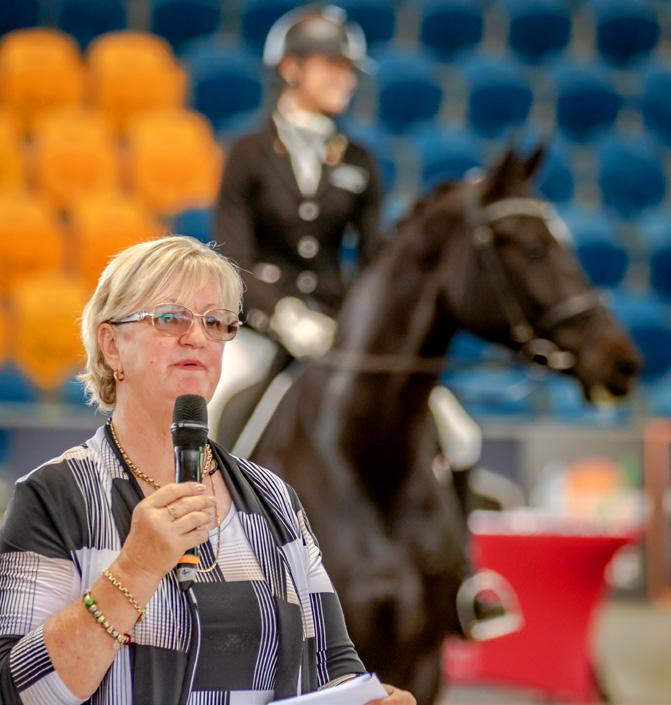
scholarship to NEGS in Armidale, a school renowned for its world class equestrian centre with its elite coaches, programs and training facilities. It was while at NEGS that Elise trained under former Olympian Imtiaz Anees, developing the skills to take Tulla to second place in the 2018 Equestrian NSW Interschool’s EVA95 Championship. The pair, who represented NSW and were placed fourth at Interschool’s Nationals that year, also enjoyed dressage wins and a team 120cm six bar show jumping win.
Sadly, Elise’s time at NEGS was limited to eighteen months due to family financial pressures.
Today, Elise is in her final year of school. COVID-19 and continuing family financial pressures meant it was difficult to keep Tulla in the work required to maintain him. Unfortunately he was sold, sadly leaving Elise without a mount.
However, Elise has partnered with Melanie Schmerglatt to ride a tricky three-year-old. Melanie says that Elise is demonstrating natural talent, empathy and maturity beyond her years to bring this horse on.
It is her drive, determination, maturity and natural talent that makes Elise Payne such a deserving winner of the Remi Stud Scholarship, and we wish her every success into the future.
Thanks again to Cheryl and the team of supporters and sponsors who make this valuable scholarship possible. It truly is an amazing opportunity for a deserving young rider to receive the support they need to enter the Australian equestrian industry.
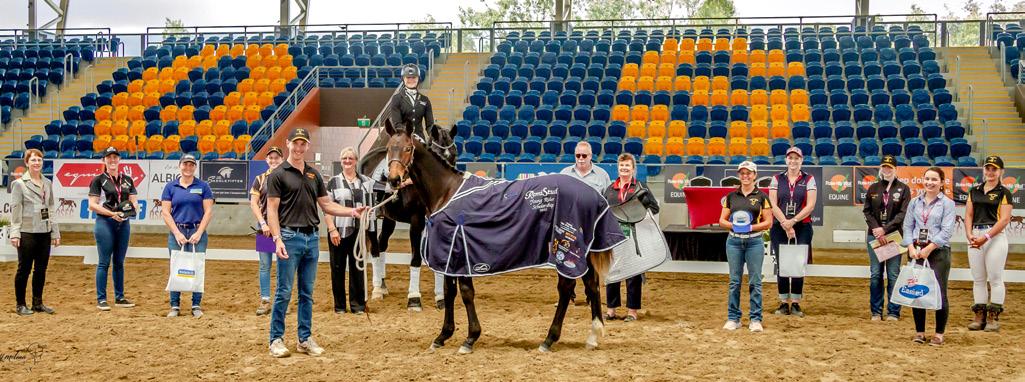
Hannah Hawkey and Palamo Awesome Exposure at the 2019 Caboolture Summer Gala Series in their second ever dressage test. Hannah was the youngest rider to compete (Image by RowanW Photo).
AROUND THE TRAPS
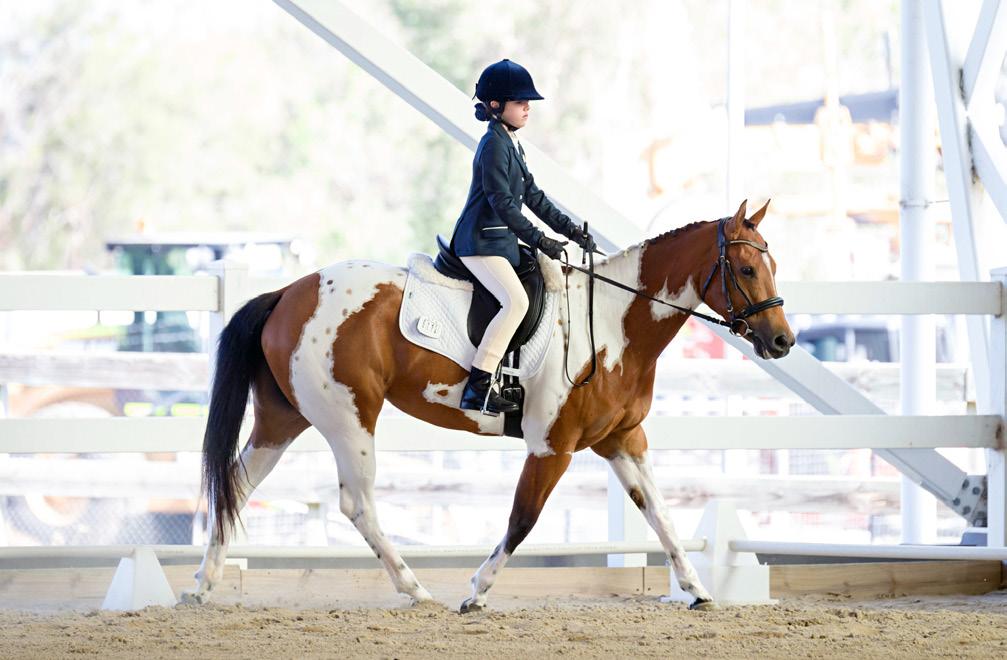
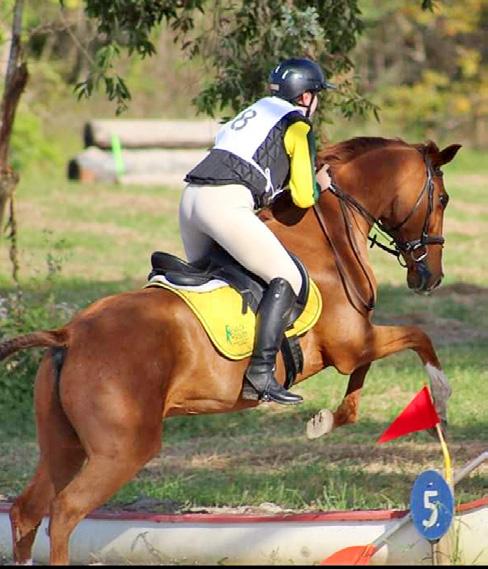
ABOVE: Eden Jerinic and Dawnmaw Smarty in their first cross country at the Herbert River Pony Club (Image by Colleen Jerinic). RIGHT: Von Robertson, OTT Herbie and Pandy share a quiet moment at home (Image by Craig Higgins).
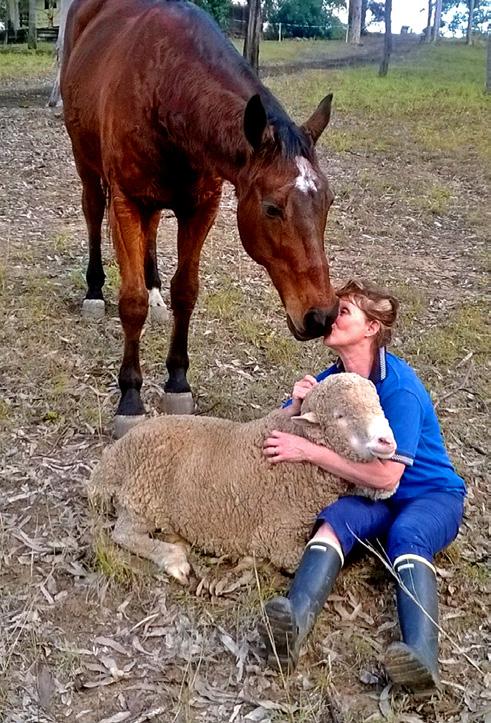
SADDLE REVIEW
Defiance Dressage
After travelling the globe Dr Clarissa BrownDouglas now calls Bendigo home. It’s where she’s settled with her husband, two children and a horse called Pi.
Dr Clarissa BrownDouglas, originally from Wellington in New Zealand, has ridden all her life. As a child, she was fortunate to have parents who were happy to drive their horse-mad daughter from their suburban home to a riding stable where she could indulge her passion.

Clarissa later had horses of her own and was a keen eventer. But then her career as an equine nutritionist with Kentucky Equine Research, a job she loves, intervened, and for several years Clarissa she lived and worked in the US. The next move was to Melbourne, and Pi out for a ride with Raffie, which became her base while Pi’s bestie, she travelled the world working racing with horse owners, breeders along behind. and trainers providing nutrition advice for their equine athletes. would be more accurate. We have a Then the opportunity arose to move Labrador called Raffie, and she and to Bendigo, Victoria, and Clarissa Pi are best mates,” laughs Clarissa. and her husband relocated to the old gold rush town in 2014. Originally bred to be a small dressage horse, Pi grew too tall As life settled into a steady rhythm, to fulfil that role and subsequently it was time to think about owning joined Clarissa’s family, of which another horse, and this eventuated he is a much-loved member. when Clarissa purchased a stunning Courtesy of Pi’s mixed heritage, finding OTT dapple grey who unfortunately, a saddle to accommodate his solid body proved not to be The One. with its sloping back, high withers, and And then along came Pi: “He’s a prominent shoulders, was always going beautiful German Riding Pony cross to be challenging. “I enlisted the help Thoroughbred, who at 16hh is a teddy of a saddle fitter, who assessed Pi and bear, or perhaps a giant Labrador gave me a list of saddles that might suit
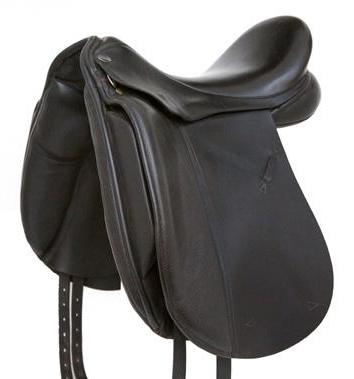
us both. I’m really quite tall with very long legs,” Clarissa explains.
Clarissa had heard about The Saddle Hub through friends and decided to visit their online store. “There were a couple of saddles there that caught my eye, but then I saw the Defiance, which was the right size and a very good price,” she says. “I loved the fact that The Saddle Hub gives you a 14-day period to trial their saddles, which I really needed. But as it happened, it was first time lucky – the saddle was perfect, I’m loving it.”
Given that Pi is only six, there’s every possibility that he might change shape and need a different saddle. If that’s the case, Clarissa will simply go back to The Saddle Hub. But for now, it’s time to enjoy the comfort of her Defence Dressage Saddle as she rides her sweet, sensible Pi. And when her children are older Clarissa may even consider getting into some dressage, but right now: “I’m a very happy hacker,” she says with a smile.
The Equestrian Hub has a wide variety of second-hand saddles, so be sure to visit www.equestrianhub.com.au and browse through their fantastic range.
All saddles come with a twoweek trial, finance options, and a courier right to your door.
Taylor Smith and Karizmah Tiara look mystical in this stunning fantasy shot (Image by La Bella Vita Photography).

AROUND THE TRAPS

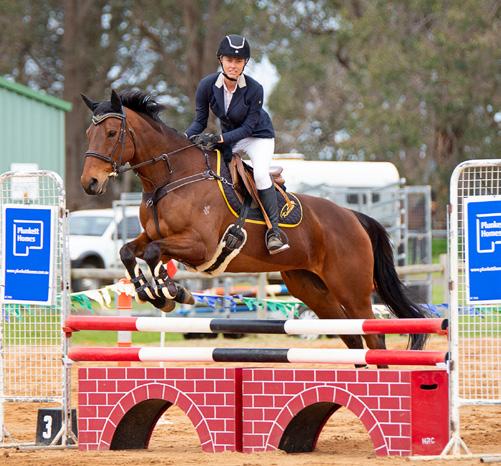
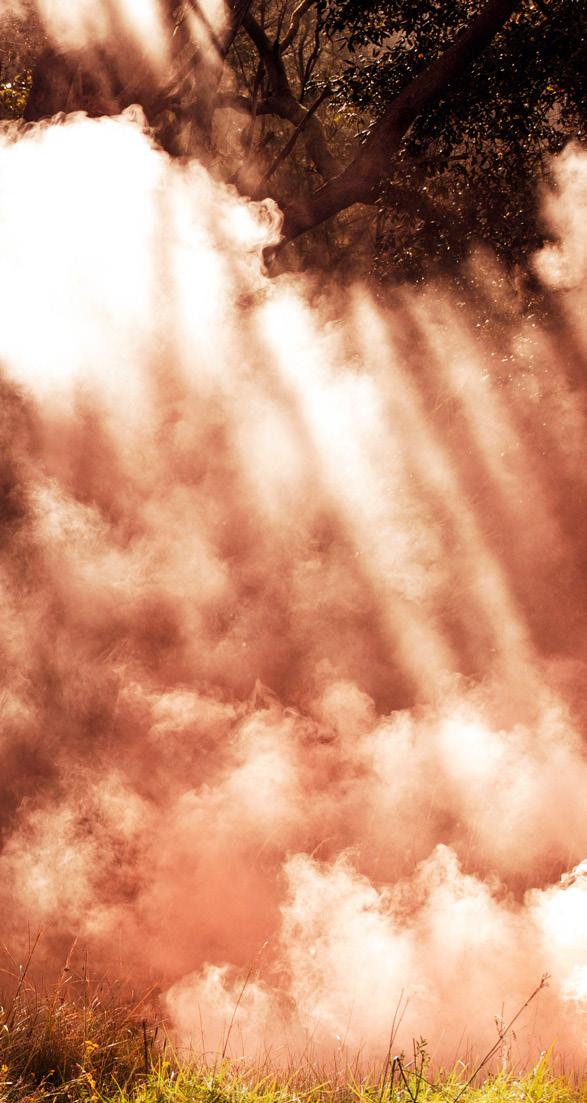
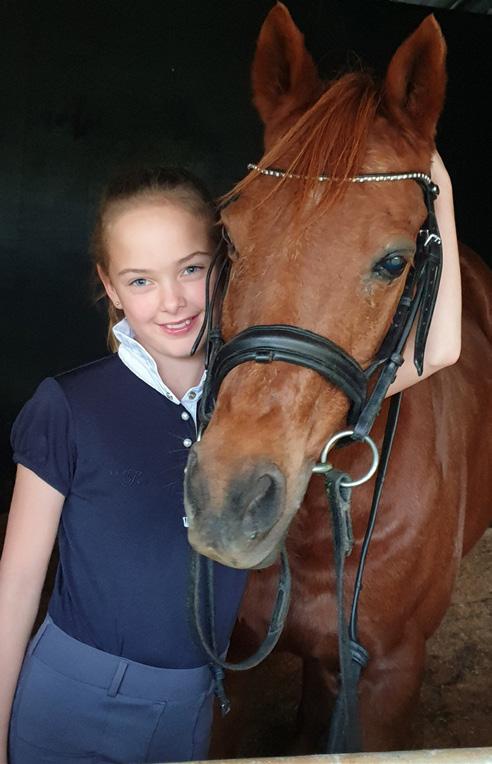
FAR LEFT: Julie Nafe and Gun Lobby won the Ladies Side Saddle Over Fences class at the Quentin Fall Classic in Pennsylvania USA (Image by Melinda Harding Photography). LEFT: Eva Lewis and OTT Holland Park Vienna placed 2nd in the 95cm and 4th in the 105cm at the Dardanup Showjumping Day (Image by Chrissy May Photography) ABOVE RIGHT: Chelsea Mead and Tilley Park Top Cat. The pair represent St Paul’s Lutheran Primary School in interschool dressage events (Image by Brendan Mead). RIGHT: Shanniah Bartle riding Magpie at Wallaby Hill (Image by Melissa Goodson, Snapshot Australia).
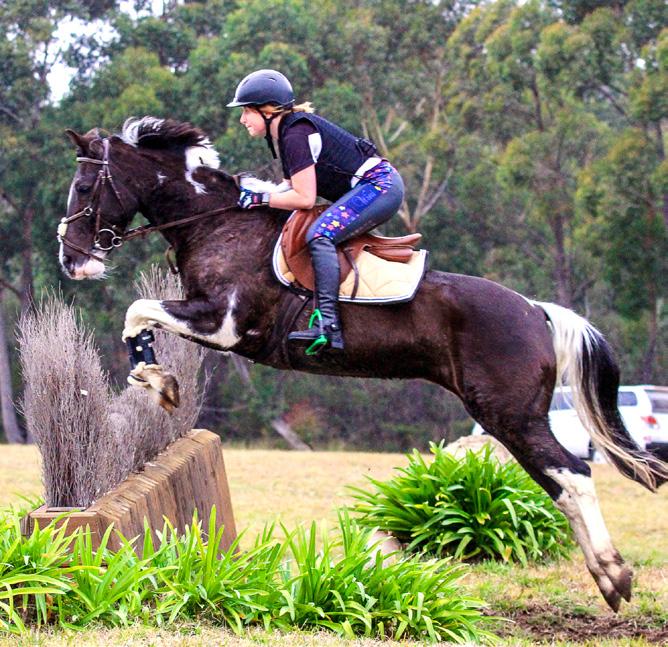
Stitching the front of a traditional stock saddle.
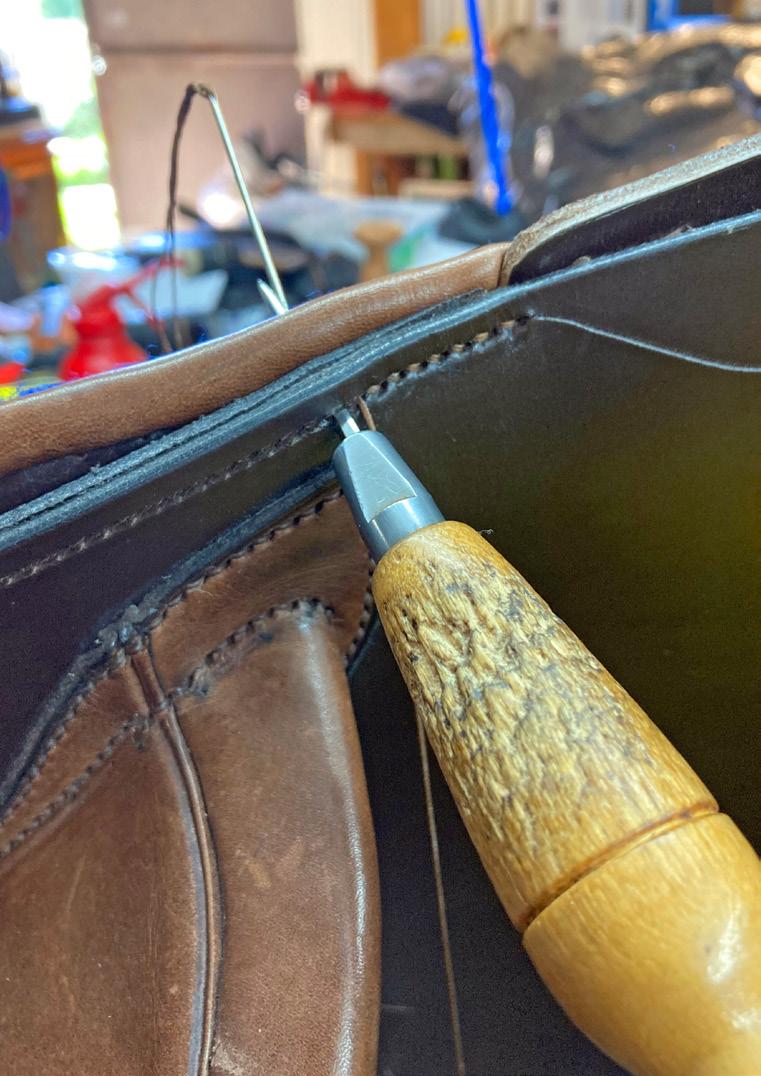
ON MY TACKBOX
A saddler’s tale
Have you ever wondered what goes into the creation of a custom-built saddle? Master saddler IAN LANCASTER has been making them for 40 years, and knows a thing or two about his craft.
Binda is a village on the NSW Southern Tablelands. The population numbers a mere few hundred people, one of whom is Ian Lancaster, a master saddlemaker and these days, one of a fairly rare breed.
Born in Dapto in the NSW’s Illawarra region, Ian’s family later moved south to Berry, and it was there that he visited a local saddle and shoe maker to have the metal studs in his football boots replaced. He left with not only his boots, but also the offer of an apprenticeship. Fifteen-year-old Ian jumped at the opportunity, which proved to be the start of a life-long career.
Ian makes saddles for all disciplines, bringing an admirable degree of artistry to his work. Over his 40-plus year career, he has created saddles and harness for several movies, and is the only saddler to have won the Overall Showcase of Excellence at the Melbourne Royal, which he achieved in 1998 with a stunning two-tone dressage saddle.
When a client contacts Ian wanting to purchase a custom-made saddle, it’s the start of quite a complex process: “I take into consideration the size and shape of the rider and the horse. If the enquiry is from a local, I’ll go and take measurements myself. If people ring from interstate or overseas, I give them a list of measurements that I need for both themselves and their horse, as well as photos of the rider. From this I can gauge their size and shape, and then I work things out from there.”
Ian has an adjustable saddle stand that he sets up to match each saddle’s shape and size. “I don’t make the saddle trees myself,” he explains, “but I do have them made to specifically fit each individual saddle. I have hundreds of leather cutting patterns in the workshop, so I pick one that I think will best suit the rider. For example, if the rider is a little wider in the thigh, they may need to have the flap cut wider, if they’re short in the leg the flap should be made shorter, and for someone with a long thin leg, I’ll choose a
A beautifully crafted turnout saddle. pattern for a longer, narrower flap.” But when you’re custom fitting a rider for a saddle, there’s more to it than just the length of their legs. “The width of their hips and the shape of their rear also have to be taken into consideration. When you shape a saddle seat to suit a rider who’s a little bit heavier behind, padding has to be taken out of the seat to allow them to fit into the saddle with their hips rotated into the correct position. But if their body build is fine and slender, then more is left in the back of the saddle so that they are correctly positioned,” Ian says. And let’s not forget the horse! “When I’m measuring a horse’s back for a saddle, I ensure that the bars running along the side of the tree will fit the horse correctly, and the angle at the front of the gullet must match the angle of the wither so it sits parallel without touching at the top or the bottom. If it does touch, the tree is either to wide or too narrow, and once you add the rider’s weight to it, it’ll wind up causing pressure points in those areas. To some extent you can make minor adjustments with the bottom panel to make it fit, but if the angles aren’t correct, you’ll still have a pressure point in those areas. Finally, the cantle has to be sitting up at the right angle too, to suit the rider as well as their discipline,” he says. Over the years, Ian has developed a couple of pet saddle-making peeves, one of which has to do with riders and
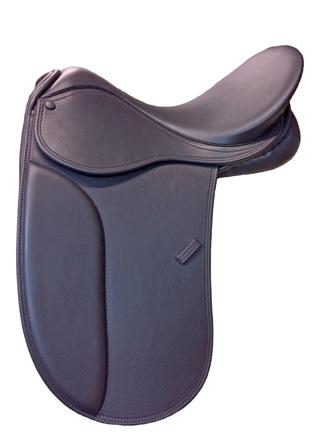

Nearing completion: a traditional stock saddle. the horses they choose. “There are too many riders who are not suitable for the size horse they’re looking to ride. They’re heavier people who still want to ride a smaller pony, and that’s a real problem when it comes to the saddle. If the saddle is made to suit the rider, it almost certainly won’t fit the size and shape of the horse’s back correctly.” Made for a five-year-old girl, this pretty 13-inch saddle was a big hit. Ian often comes across this problem when someone’s been given a horse, or has bought one that they fell in love without considering whether or not they’re a good match. “The build of different breeds and cross breeds has
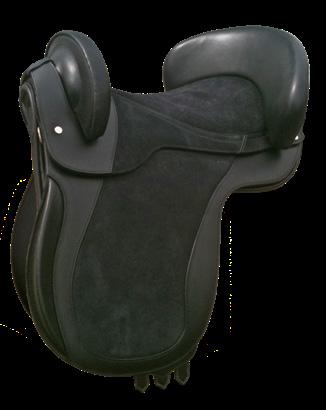
An elegant Spanish riding saddle with

suede inserts. an effect on their weight bearing ability. For example, your Arabian has two ribs less than a Thoroughbred, Warmblood, or other larger breed, which makes their back shorter in length. So the weight bearing area is less in an Arabian than a larger horse. It’s not just a case of ‘I like that pony, that’s the one I want to ride and I’ll get a saddle made for it’, you have to match the horse with the rider,” he says.
Yet another issue arises when a horse has been bred from two essentially incompatible breeds, resulting in anomalies in their conformation that make it very hard, or nearly impossible to correctly fit a saddle.
Ian also points out that most standard saddles are made to suit an average size, and very few people are of an average size. “My main customers are usually people who’ve had trouble getting a saddle that’s a good fit for both them and their horse. Although a top quality saddle is a 40 to 50 year investment, one that will certainly outlive their current horse, I always suggest that they get the saddle made to fit that horse anyway. If they have several horses, the saddle should be made to fit the widest horse, and then saddle cloths and shims can be used to adjust the saddle to fit the narrower horse. But of course you can’t go the



Woven stretch belt – 35 colours and patterns available $25 or $15 Gold and Platinum Members https://membership.equestrianhub.com.au Equestrian Hub Membership perks

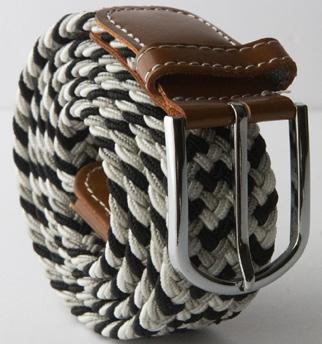

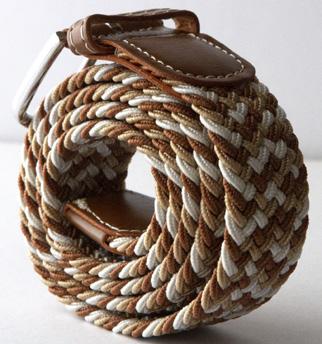
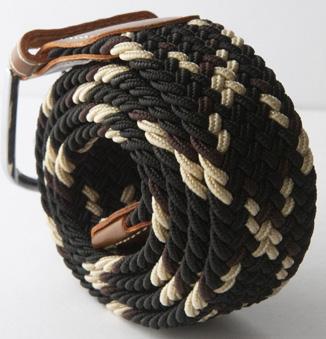
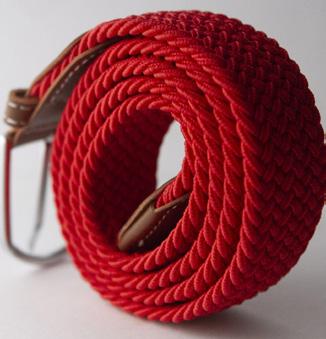



other way, you can’t make a saddle to fit a narrow horse and then expect it to fit a wider horse,” he adds.
If you can’t afford to buy a custom made saddle right now, Ian has some advice to help you find the best possible saddle in your price range. “I’d suggest you go and sit in the best quality saddle you can find, one that’s the best shape for you and is the most comfortable – and that doesn’t necessarily mean the most expensive, because the mark-up on saddles can be more than the saddle’s really worth. And if that saddlery doesn’t have a similar saddle in your price range, shop around. Look at different brands until you find one that’s a close match and is in your price range.”
Ian uses only the best quality leathers in his saddles, and he strongly suggests that if you aren’t buying an Australian made saddle, you should choose one that’s been made in either the UK, Europe, or the US. Saddles made in Mexico, India and similar countries may be cheaper but, for a number of reasons the quality of the materials is significantly less.
And Ian has one final word of advice if you’re in the market for an off-the-peg saddle. “If you can, find a reputable saddle fitter who can measure the saddle and fit it to your horse. Always look for someone with plenty of practical experience. You need a saddle fitter who knows how to put a shim in, how to On the stand: a completed side saddle with girth.
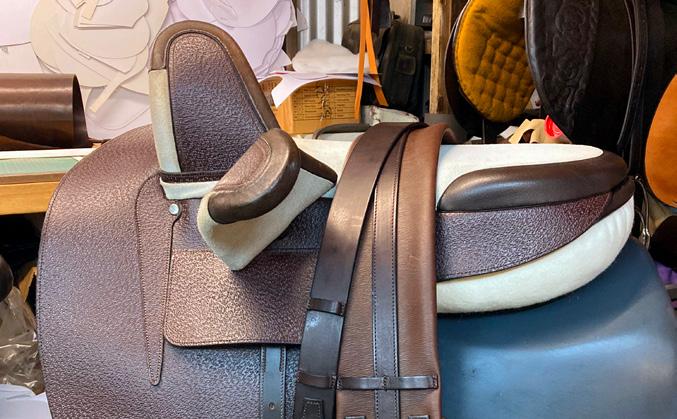
change the gullet, how to move the girth points if they’re not set in the correct position, and how to adjust the stuffing in the saddle to get it to fit correctly.”
To see more examples of Ian’s extraordinary work, visit Redback Saddles at bit.ly/3kqWSLm, or Ian’s personal Facebook page at bit.ly/35HQYB8, or email an enquiry to ianlancaster@activ8.net.au .
SADDLES WANTED
The role of The Saddle Hub is to make the process of selling your saddle as effortless as possible. If you have a saddle that doesn't suit you or your horse, or is no longer needed, get in touch with us about how we can assist you in re-homing it.



Find more info at: equestrianhub.com.au/sellers-information/
AROUND THE TRAPS
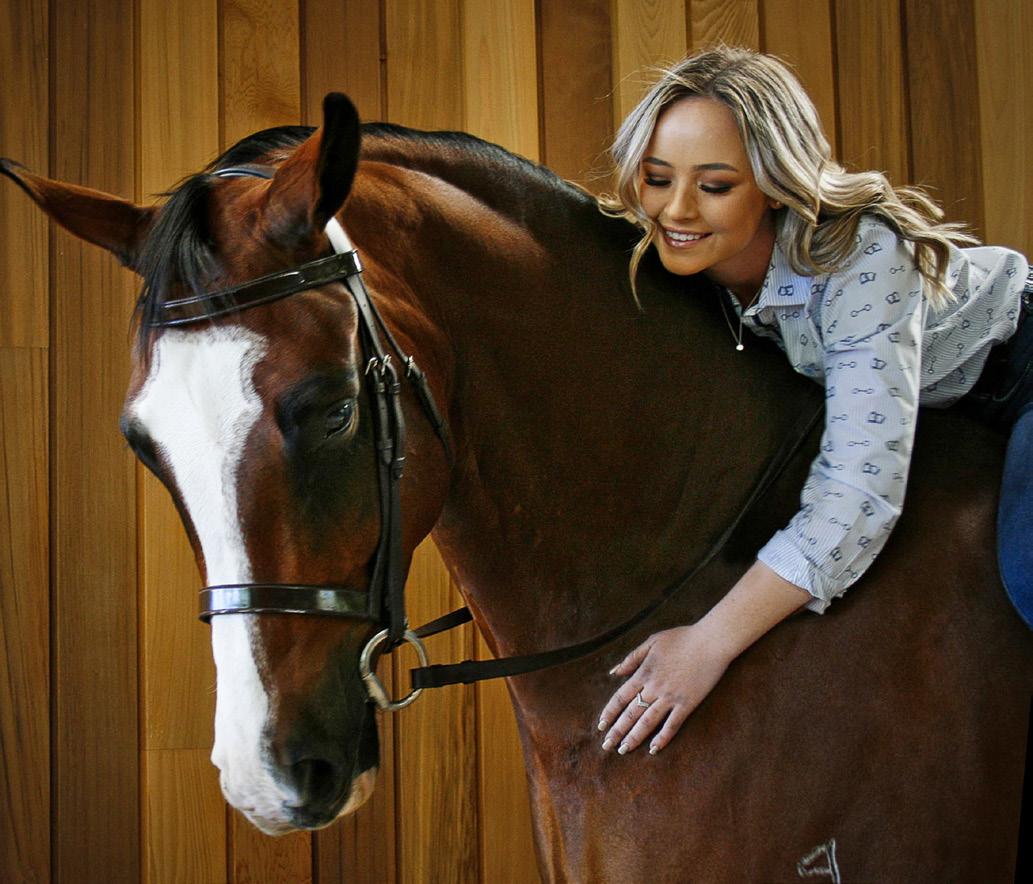

ABOVE: Sarah Read and Heathmont Stedinger at a different type of event – a photoshoot (Image by Beautiful A Photography). LEFT: Annabel Dignam and French Buttons were given a lesson by Olympian Rebel Morrow at the 2020 Sydney Eventing Hit Out (Image by Melanie Dignam).


LEFT: Stacey Heath and Close the Book came 1st in the Senior division at Mackay North Pony Club’s One Day Event (Image by Pink Lady Photography). ABOVE: Rebecca Hopkins and Strawberry Sundae well clear at the 2019 Tamworth World Cup Show (Image by Oz Shotz). BELOW: It’s love! 3-year-old Ethan Fogarty and Snowdon Vale Eclipse at the annual Huntingfield Pony and Riding Club Spring Show (Image by Sarah Fogarty). BELOW LEFT: Georgia Nettlefold aboard Chance competing at the Mt Evelyn Darby (Image by Jasmyn Sanders Photography).
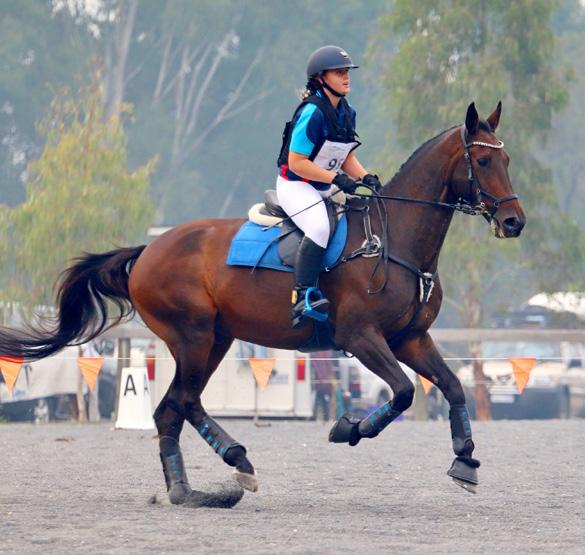

TRAINING TIPS
Endurance for the long haul

Endurance riding is the odyssey among equestrian sports. No other discipline requires a horse and rider to traverse such varied terrain and travel such great distances as this one, writes CHRISTINE ARMISHAW.
Strappers hard at work during the 2017 World Youth Endurance Championships (Image courtesy the Radny family).
In the sport of endurance riding, horse soundness, fitness and overall health are of utmost importance. Added to that, rider gumption is essential. Vet inspections are held at multiple locations throughout a ride and any horse that doesn’t pass the mandatory checks can be vetted straight out of the competition.
Those are stringent requirements, so you may be wondering how horses are trained so they can successfully compete in what are often rugged conditions. In search of answers, I spoke with Rebecca (Bec) Radny, who competes in endurance right up to FEI level alongside not just one, but both of her highly successful parents. The endurance gene runs strong in this family.
Bec has been involved in endurance for 18 years, pretty good going considering she’s just 23 years old. In 2014, she placed 7th overall and 2nd in the Junior Under 18 section in the Tom Quilty Gold Cup, arguably Australia’s most prestigious endurance event. She also represented Australia at the 2017 World Endurance Championships for Juniors and Young Riders in Italy, and was a member of the 2012 Australian Endurance team as groom for her mum, Jane Radny, when she competed in the Trans-Tasman Championships held in New Zealand. In the same year, Bec again joined the Australian team as a groom for the World Endurance Championships in the UK, this time for her dad, Norbert Radny.
It’s fair to say that this trio has a pretty good idea of what it takes to get a horse to the top level of endurance.
At home in Western Australia, as well as further afield, the family regularly compete against each other, taking turns in sharing the glory of the podium. The Radnys are super strategic - they plan everything out. “We don’t just go out there and flog it,” says Bec. Right down to the day-to-day routine, all the details are refined. Bec’s mum Jane on Kib (left) and Bec aboard Max, enjoying a 40km training ride at Collie (Image by Down Under Images).
Longevity is key This equestrian family approaches the training of all their horses with one motto: every horse is to have a decadelong career, if not longer. Bec stresses the importance of not overtraining. Throughout the season, running from March to October, each equine athlete is worked three to four times per week. These sessions start with an hour on the horse walker. “This allows them to warm their muscles and get their joints

lubricated, it also saves me a lot of time, as I work full-time as a teacher,” shares Bec. Being riderless also allows for horse fitness to be built gradually, without human weight putting extra and unnecessary strain on precious limbs.
The ridden components following the walker warm-ups take place out in the national park backing onto their property. Over the course of a week, each horse does a couple of 7km loops, primarily spent in walk and trot with lots of stretching, then one longer 20km workout to further build on fitness. In line with keeping the horses fit, healthy and sound, for every 10kms travelled they get one day off. “This is especially necessary when training on hard or concussive surfaces,” Bec explains.
An intriguing point from the Radny training schedule that struck me is the daily integration of competition simulation. “Every time we train, we simulate a vet check,” Bec tells me. “We take the heart rate after every ride. We
Bec and Steel Poppy Regent leading the pack, followed by dad Norbert aboard Sandstorm Spellbound (Image by Vince Evans). BELOW: An example of the peloton style formation (Image by Down Under Images).
put the [heart rate] monitor on before we strap them. We’re checking for the speed of recovery. How quickly the heart rate comes back down to that horse’s normal is an indicator of fitness.”
And that’s not all, following strapping, these dedicated endurance professionals also trot each horse out to check for evenness. Full of endurance wisdom, Bec outlines the details: “We trot them out 20 to 40 metres and back, always on bitumen - it’s unforgiving and will show up any signs of unsoundness. If necessary, we film this so we have a baseline to check against.”
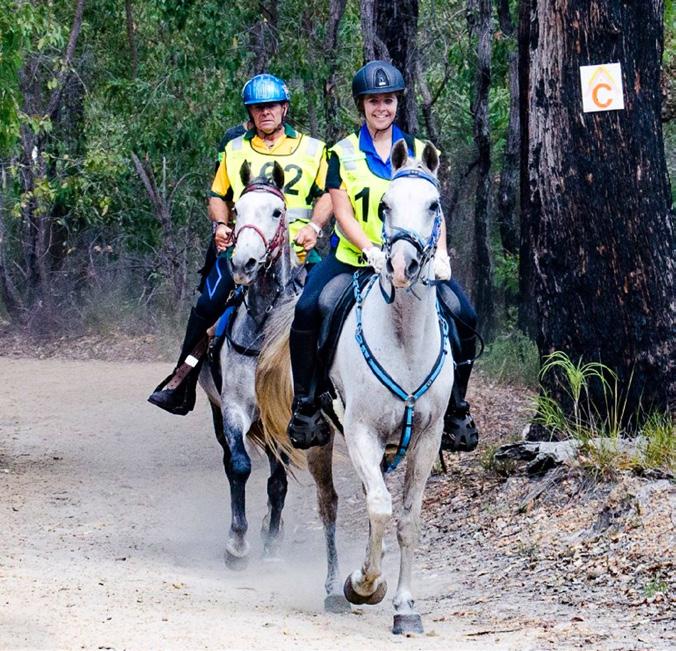
A training aspect the family has employed in more recent years is the addition of groundwork and behavioural connection. “We had a couple of horses not wanting to get on the truck and float. Groundwork has been the answer,” says Bec, “it helps them ‘make the right choices’.” She chuckles as she likens the horses to the students she teaches

at school, then continues: “We use plastic bags and flags to desensitise. You see the personality and get to know your horse. With groundwork, my main horse West Coast Kia has improved in confidence. While not quite able to be off all on her own yet, she is now able to get out in front during a ride.”
Crunch time Competitions are attended roughly every four to six weeks. When it comes to the day of the ride, strategy remains the name of the game. “It’s a bit like cycling,” Bec tells me. She is referring to the peloton formation employed in a cycle race. She describes how a horse and rider combination will lead the pack, doing more work than the others as they cut through the most air resistance. Being on a horse and not a bike, the rider in this position is required to pay more attention to what’s coming up ahead. The whole process is quite methodical. “Each horse has different strengths, which wax and wane throughout the event,” Bec says. “We pair horses up, to each bring out the best in the other, and they adjust to each other’s speed. We choose one that’s a solid leader, who won’t look and shy at the start.”
The staple in the stable at the Radny residence is a horse named Reg. He competes in every second event or so and makes a fantastic lead horse. “He
doesn’t shy, gets out there, does his job and sets the pace,” Bec says fondly. When I question how much difference this could really make to the overall result, she had the perfect example of the implications of a bad match. “A few weeks ago, two horses we paired up for the first time were a terrible combo,” she recalls of a nappy couple that simply didn’t want to move out and get going. “We tried riding them side-by-side, then one in front of the other, which was a little better, but they only really settled properly once they realised they were going back towards home. Endurance rides are set up as a circuit and horses are very location-aware, they can tell when they are heading back to base, even though they have only been in that location for a matter of days.”
Endurance rides can be distances of 40kms (considered training rides), 80kms, 120kms and 160kms. Vet checks usually pop up every 40kms, where horses are assessed for soundness and heart rate, both of which must be deemed satisfactory in order to be allowed to continue. “The checkpoints are where you strap your horse and offer them food and water,” Bec says.
These stations are where riders must also remember to look after themselves. They are kitted out with bottled water to mitigate headaches and lollies for a sugar hit. “Party mix,” Bec offers when I inquire as to which lollies are available. “I really like milk bottles,” she laughs when I probe further. Lots of rest makes for happy horses
Travel to different locations, staying away from home, and, during the longer rides, not being ‘trickle-fed’ as they would be normally, all contribute to massive change for the horse, something the Radnys recognise and take into serious account. So, after a competition, the horses get a full two weeks off - practically unheard of in other disciplines. “Horses can maintain
Bec and Estragon before the 2017 World Endurance Championships for Juniors and Young Riders (Image courtesy the Radny family).

The horses adapt to each other’s speeds: West Coast Kia is comfortable cantering, whereas Jest a Golden Gift prefers to trot (Image by Down Under Images).
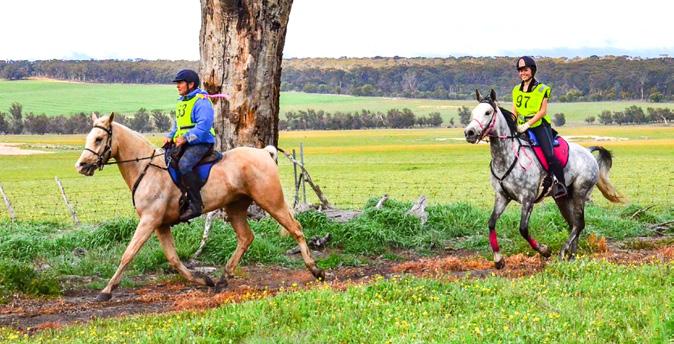
their fitness for six weeks,” explains Bec, “our aim is to always keep them fit and healthy, and that includes mentally.”
The longest rides of 160kms are only ridden once every one to two years. These are a huge ask of both horse and rider, and undertaken only on a ‘needs must’ basis, to qualify for a national event or state championship, for example. In addition, these big events are always end-of-season rides, after which the horses are turned out for a well-earned long spell. Bright-eyed and bushy-tailed, they return fresh and eager for more intrepid action the following year.
“Endurance is the ultimate test in horsemanship,” Bec concludes. “You don’t have to be the best rider - some of the best are self-taught and have never had lessons. But you do need to really understand and manage your horse and the terrain you are riding.”
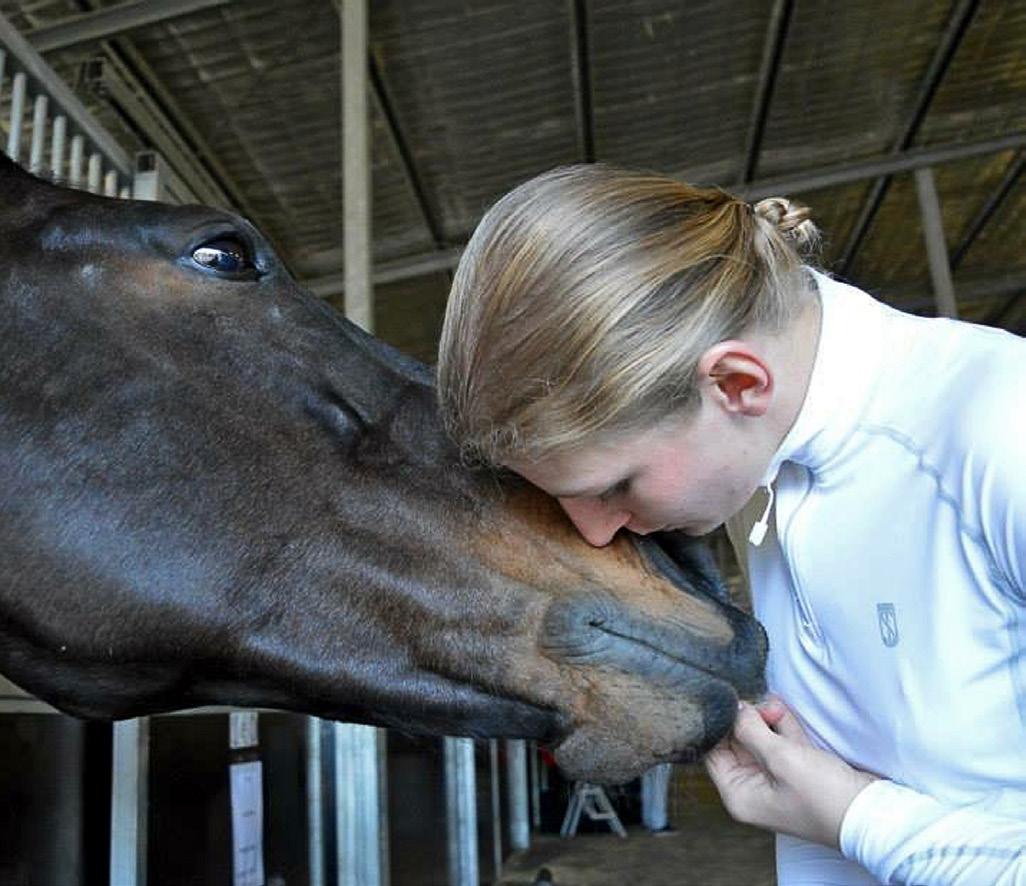
Phoebe with the now semi-retired Amajah (Image by Tarni Woodhead).
YOUNG RIDER
The tough keep going
For Phoebe Roche, life has had challenges, but her tenacity and courage have earned this young rider a considerable degree of success, writes AMANDA MAC.
Phoebe Roche is a Grade IV FEI Para Rider. Look her up on the FEI website and you’ll find that since 2015, she’s been a successful competitor in CPEDI3* dressage events with her horses Amajah (now semi-retired), Power of Attorney (Will), and more recently Saddleup Romper Stomper (Smartie), in freestyle individual, and team events.
Originally from Brisbane, Phoebe and her mother moved to Tooradin, Victoria, where they live in a cottage on Tooradin Estate, the property of renowned equestrian Sally Francis OAM.
It was Phoebe’s late father Doug Roche who encouraged her to start riding. As a boy, an operation on his spine
severed the nerves to his legs, and he later learned to ride at the McIntyre Centre, a Riding for the Disabled facility in Brisbane’s south west. When Phoebe was first diagnosed with cerebral palsy, Doug put her name on the Centre’s waiting list, where she began riding as a five-year-old. “It was a father daughter thing,” she says, “Mum was allergic to horses, so it was our time together.”
It quickly became apparent that Phoebe was a natural. A member of the McIntyre Pony Club squad, she was classified for Para by the time she was 15. Next was the McIntyre’s dressage squad, which is when Phoebe came to a life-altering decision: “I thought, well, you train for all the movements anyway and they’re the same whether you compete or not, so you might as well go out and put it all together in a test.” Which is what she did, starting first with Interschool and local club day events, before moving on to the world of international competition.
Does Phoebe have a competitive streak? She does, but she directs it towards herself, a challenge to be the best she can be. “And it’s training the horse to be the best they can be too,” she adds. “I rode in one competition where the prize was a bucket of carrots and I’d say that was the best prize I’d ever won because it was something for the horse. A ribbon’s a ribbon, and I’m not in it for the ribbon. For me, it’s to do the best by your horse. I’d happily come last in a competition if I knew I’d ridden it correctly.”
After leasing a number of horses, Phoebe eventually purchased several of her own. “It’s hard to find a good horse,” she remarks, “It’s got to be one with a brain that wants to learn and will listen to you. It’s a horse that you’re going to spend a lot of time with, so you’ve got to have a connection with them on the ground, they’ve got to have a personality.” Australia’s 2016 Young Athlete of the Year award, and in January this year she attained a qualifying score for the Tokyo Olympics with Smartie. She is now waiting for the Tokyo 2021 selection policy to be announced.
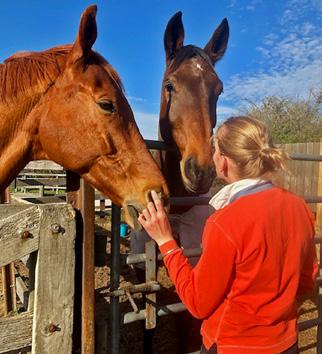
Finally, Phoebe, whose independence, dedication and hard work are the driving force behind her success, would like to acknowledge and thank those who’ve helped and supported her along the way: “There’s my mum Shaneen, my coach Sam Bartlett, Jess Ryan, Stephanie Eriksen, and my sponsors Kentucky Equine Research, South Eastern Equine Hospital, Hastings Produce, Saddle-Up Saddle World Chirnside Park and Bit Bank Australia. I’d like to thank them all.

TOP: Tokyo Olympic hopefuls Phoebe and Smartie at work (Image courtesy Equestrian Australia). ABOVE LEFT: Phoebe, Smartie and Will share that allimportant connection (Image courtesy Phoebe Roche). ABOVE RIGHT: Aboard Saddleup Romper Stomper (Image by Linda Zupanc).
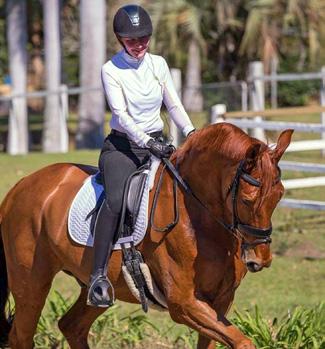
From the entire team here at HorseVibes, congratulations on all your achievements so far, Phoebe, and we wish you every success for the future.
AROUND THE TRAPS

Sarah Crisp and her 18.3hh Shire, Ingleside Lucky Chance. Lucky loves competing at any show, including the Sydney Royal (Image by Karen Inverarity).
Get featured in Around The Traps!

If you have had a great photo taken of you and your equine partner while you've been out and about enjoying yourselves, submit your photo to info@horsevibes.com.au to be considered for a starring role in our next issue! If your image is selected it will be published in the print and digital magazines and on the HorseVibes website!
www.horsevibes.com.au
horsevibes @horsevibesmag
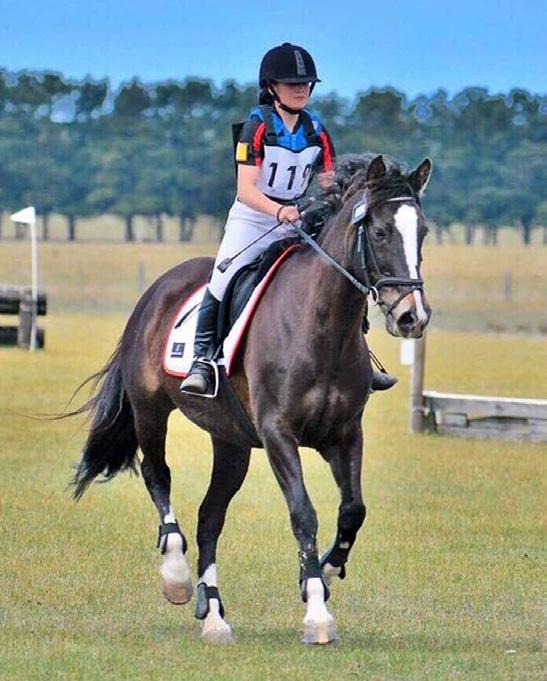
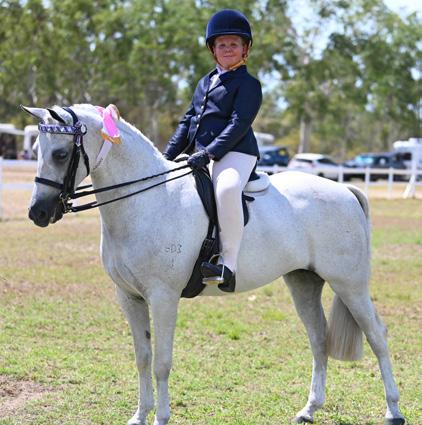
ABOVE LEFT: Jamee Warren and her Welsh Mountain x Cob on the family farm (Image by Maria Warren). ABOVE: Kobie Cook took out Champion Novice Show Pony with Jimba Miss Party Girl at the recent NQEQ Classic Show (Image by Red Hot Photography). LEFT: Makalah Crichton and Little Black competing at the Rosedale Horse Trials (Image courtesy Makalah Crichton).
Thundering home to victory in the 2018 Cox Plate (Image courtesy Racing Victoria).

PERFECT PARTNERS
Winx and Hugh Bowman
There are very few Australians who don’t know the name Winx. N. G. QUINLAN takes a closer look at the story behind the legend.
The bay filly sure didn’t look like much as she lined up at Warwick Farm Racecourse on the 4th of June 2014. Even her owners had more confidence in one of her stablemates to win or place. But three-year-old Winx won her first race that day over 1,100 metres, an event that marked the beginning of a stunning five year career as a recordbreaking racehorse, one who many have called the greatest of all time.
Winx was foaled on the 14th of September 2011 near a village named Jerrys Plains in the New South Wales Hunter Valley. She was a product of the Australian branch of the famous Irish Thoroughbred operation Coolmore Stud, and was sold as a yearling
for $230,000 in January 2013.
It wasn’t long before the filly began to show some serious promise as a racehorse. Her sire, Irish-born stallion Street Cry, had won the Dubai World Cup in 2002, but her dam, a New Zealand bay named Vegas Showgirl, had a brief and undistinguished career consisting of no wins from four starts. Winx’s name, indirectly inspired by her mother, was a reference to the winks given to showgirls by men in the front rows of burlesque shows in Las Vegas.
Teamed with New Zealand-born trainer Chris Waller, the bay filly from Jerrys Plains won both races of her 2013-2014 debut season. In her next season as a three-year-old, she scored her first feature race success when she won the Furious Stakes at Randwick in September 2014. During that season, Winx took four wins and three second places from ten starts. It was then that the racing world began to pay attention.
During the running of the Sunshine Coast Guineas in May 2015, Winx was trailing the field as they came into the last stretch, yet somehow she managed to find her pace and win the race by one and three-quarter lengths. It was an effort that her jockey Larry Cassidy described as “breathtaking”.
In her next season, 2015 to 2016, the now four-year-old Winx put in another stellar performance. In October 2015, she started as favourite in the Cox Plate at Moonee Valley Racecourse in Melbourne. She won by four and three-quarter lengths and was timed at 2:02.98, a new record for both the race and the course. Her rider that day was Hugh Bowman, the champion Australian jockey who went on to ride Winx to victory in twenty-five Group 1 races. In 2017 Bowman won the World’s Best Jockey award, presented by the International Federation of Horseracing Authorities, and was later inducted into
Winx and Hugh Bowman, a winning team (Image courtesy Racing Victoria).
the Australian Racing Hall of Fame.
It was not the first time that Bowman had ridden Winx. He had steered her to her first major win during the Sydney Spring Racing Carnival in September 2014, as well as riding her into her second place finish the following month in the Flight Stakes at Royal Randwick. However Winx and Bowman would not meet again until six months later, when he rode her to victory at the Queensland Oaks in Brisbane on the 30th of May 2015. Not long after this win, Bowman was assigned to the bay as her permanent jockey. He partnered with her for the next four racing seasons until her retirement in 2019. With Bowman in the saddle, Winx produced 32 wins and one second placing from their 33 starts as a team.
During Winx’s racing career, she won 37 of her 43 starts. That in itself is a remarkable statistic. Yet what makes Winx stand out from the rest is that she won 33 of those races in succession, the longest winning streak ever for an Australian horse. Winx was named Australian Champion Racehorse of the Year four times, as well as twice being recognised as the World’s Top Ranked Turf Horse. In 2018 she tied with British colt Cracksman for the title

of World’s Best Racehorse, with both horses rated at 130. Also noteworthy is that Winx posted this rating for three consecutive years, a feat second only to Black Caviar’s. She is also the only horse ever to score four Cox Plate wins.
Winx capped off a magnificent racing career by winning the Queen Elizabeth Stakes at Randwick in April 2019. It was the third time she had taken the honours in that auspicious race, and the first time since 1923 that any horse had won the race three times in succession. Winx has been retired since September 2019, but the bay horse known as the Mighty Mare had already secured her place in the record books as one of the finest Thoroughbreds in three centuries of racing, winning over $26 million in prize money.
And in a less than happy ending to this otherwise triumphant story, Winx, who was soon to be a mother for the first time, lost her foal in October. The foal, a filly, was sired by I Am Invincible, Australia’s most expensive stallion, and was expected to be worth almost $10 million. However, we have no doubt that the story of this recordbreaking mare is very far from over.
20 QUESTIONS
20 Questions with Alex Townsend
Alex Townsend, 4* Eventer and Level II Instructor, along with husband Derek Pascoe, a Director of Photography and keen eventer, are the owners of Wallaby Hill Farm, a private training facility for horses.
Q: At what age did you get
bitten by the riding bug?
A: About four I think. It’s a long time ago now!
Q: Did your parents want you to go
into a more ‘normal’ profession?
A: My parents aren’t horsey at all and they paid a lot of money for my education and sent me to university twice: first a BA then a Masters in Journalism. So they were definitely keen for me to use that and go into a ‘real’ profession. Before doing the Masters at UTS in Sydney, I was a diving instructor for 18 months in Egypt. The goal then was to become an underwater photographer, but then the horses got a hold of me again.
Q: How did you meet your
husband, Derek?
A: We met while diving in the Red Sea. He was living in London and working abroad as a cameraman in various war zones. After re-meeting Derek when I arrived back in London he was keen to return to Sydney, which he did in November 1999, and I followed in January 2020 to start my Masters.
Q: Have you taught Derek anything
about being a cameraman, and has Derek taught you anything about riding?
A: In the early days I could digitally edit stuff well before Derek could. He was a bit old school. Derek pipes up in the background, “Duck under trees!” A reference to 2015 when Alex sustained multiple fractures, lacerations and broke her neck due to a low hanging tree branch at a 3-day event.

Q: Which riders are the easiest to host,
dressage, jumping or eventing?
A: Eventers, definitely! Some high level show jumpers care a lot more about cleaning poo up at their own farms than when they visit other people’s farms.
Q: If you had to switch disciplines,
what would you choose?
A: After just saying how bad show jumpers are at cleaning up I would probably go and do that if I stopped eventing.
what would you do?
A: Probably do a lot more diving! There was a week after the last event where I contemplated selling it all and buying a boat.
Q: In hindsight, what would you have
done differently when setting up Wallaby Hill?
A: A lot! We never set it up to be a big equestrian centre, not that it’s huge by international standards. We didn’t plan to run big events so as a result it’s been done in a bit of a piecemeal fashion. If I’d known what we were going to do I would have made it a lot more cohesive and user friendly. It’s a combination of eventing at someone’s house and an equestrian facility!
Q: How many cross country
jumps are on the farm now?
A: A lot! Six levels of jumps plus portables for training, so between 200 and 300.
Q: Who designs the jumps? A: Mike Etherington-Smith started designing in 2016 when we upgraded to a 4* course. Mike has been phenomenal. Obviously COVID happened and Derek Di Grazia wasn’t able to come, so Mike is now designing remotely. It will have a few new things but run along similar lines to last year. Mike is very familiar with the course and writes very comprehensive notes about where he wants the jump and how he wants it to sit. Vince Roche then signs everything off for FEI approval.
Q: What does a typical non-comp
day look like?
A: Get up around 6am, feed the dogs, then go for a run. Feed myself. Then I usually ride a bit in the morning. I don’t ride as much as I used to. Stable rider Michelle Robson rides more of the young ones as she is better at that. Later in the day I do business stuff, bill paying, event planning and thinking up the next lot ideas and plans for the place. Wallaby Hill now gets hired by nonhorsey people so there are bookings to
MAIN: The 2019 Wallaby Hill Equestrian Extravaganza Showjumpers v Eventers event: Winner of the Best Dressed, Kirsty Douglas and Cushavon Crackerjack (Image by Stephen Mowbray). INSET: Alex and Parodie competing in the 2017 CCI4*-L at Wallaby Hill (Image by Stephen Mowbray).

be managed.
Q: How do you manage everything at
Wallaby Hill when you’re competing?
A: I'm lucky to have a very good team around me who help make the place run smoothly: Sophie, Michelle, James, Maddy, and Derek, who’s incredibly supportive.
Q: If your competitors did one thing
to make your life easier what would that be?
A: On the whole Eventers are very good and very respectful. It would be really nice if they could clean up the rubbish and the manure! We try and recycle but people chuck food into bins and leave the toilets in a mess.
Q: Excluding horses what other
pets do you have?
A: Maggie who’s a retired sniffer dog; Sammy the rescue Labrador who fell off a cliff; Fink, which is a really bad name for her, a red Labrador; and Mouse the rescue cat.
you wouldn’t normally during the COVID dramas?
A: The biggest difference is I’m doing more feed ups on the weekend due to not competing as much. This has allowed me to be around the young horses that I don’t usually interact with as much and I enjoy that a lot.
Q: Do you have a favourite horse
at the moment?
A: I definitely have a favourite. I try not to, and I pretend I don’t, but Pie, my old 4* mare is my favourite, I adore her. I have a massive soft spot for anything related to her. Then it alternates between Audi and Pimms, who I compete on mostly, depending on what I am doing with them.
Q: If you could steal anyone’s horse
which one would it be?
A: I really like my friend Carrie’s horse Tarraleah Kokoda. I love mares and she’s a tough and feisty mare, a cool jumper, and good on the flat.
from Aussie eventers?
A: Be a little friendlier. There’re a lot more events in England with a lot more riders competing. Horses don’t get off the truck except to compete. A lot of events will do all phases in one day so it’s not as social. As a consequence of not being as social, it can be a little unfriendly with everyone hiding in their trucks. The Australian eventing community is much more friendly, inclusive and supportive.
Q: What could Aussie eventers
learn from the English?
A: Because the numbers are greater, the Brits run a bigger enterprise. In the UK it feels like there’s a lot more scope to have a bigger event running business, but Australia could make things a bit more efficient. The longer distances make things harder here, but that often makes it a more social occasion.
Q: Is there a philosophy or
motto you live by?
A: I feel very lucky to have what I have and I feel that it’s nice to share that.

